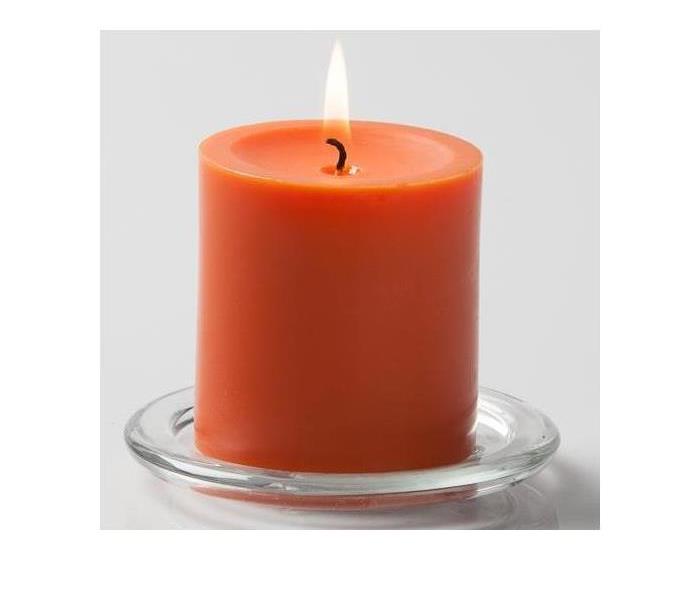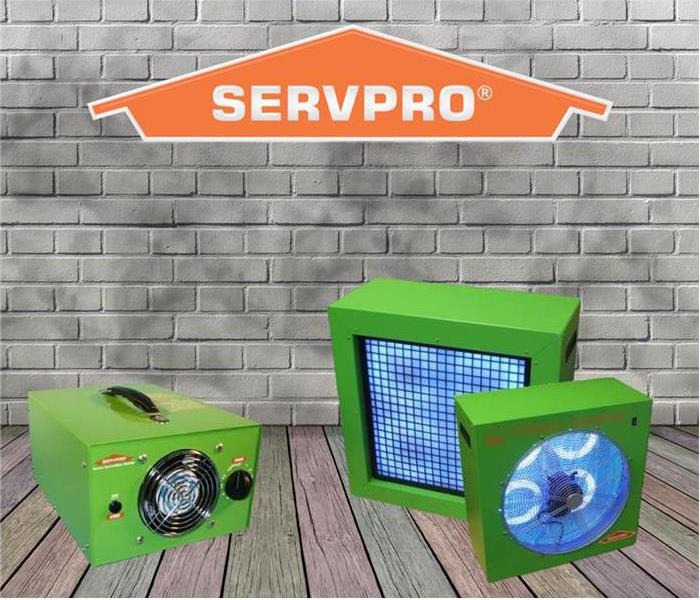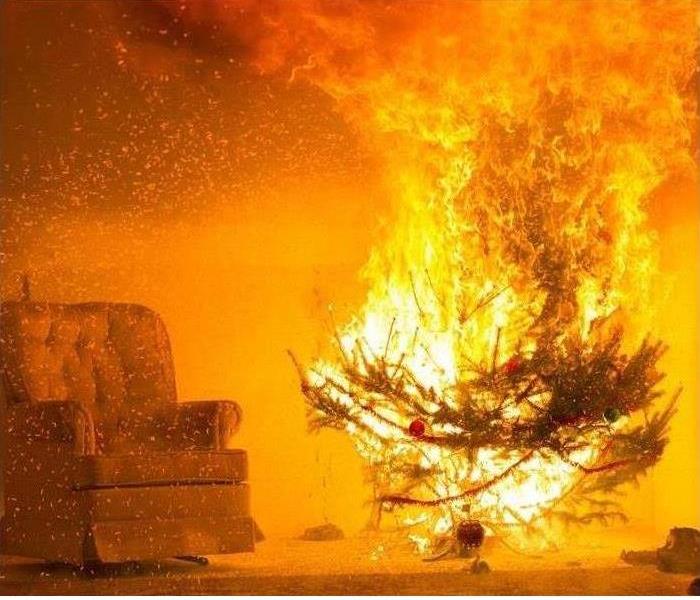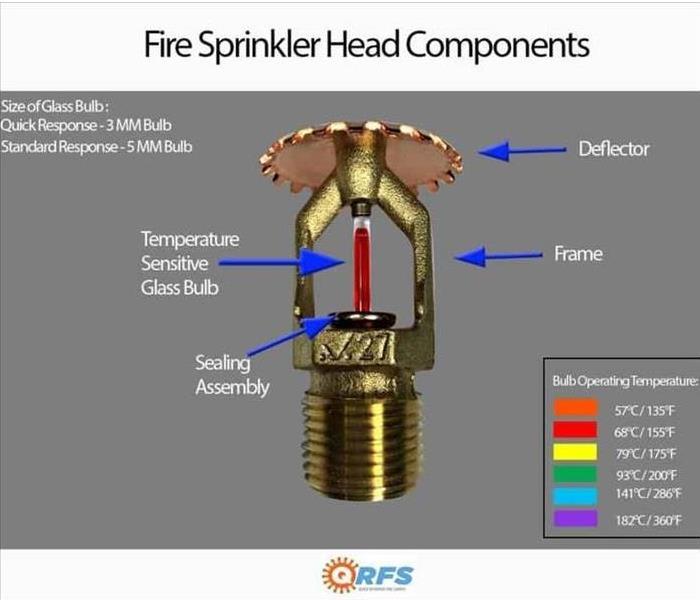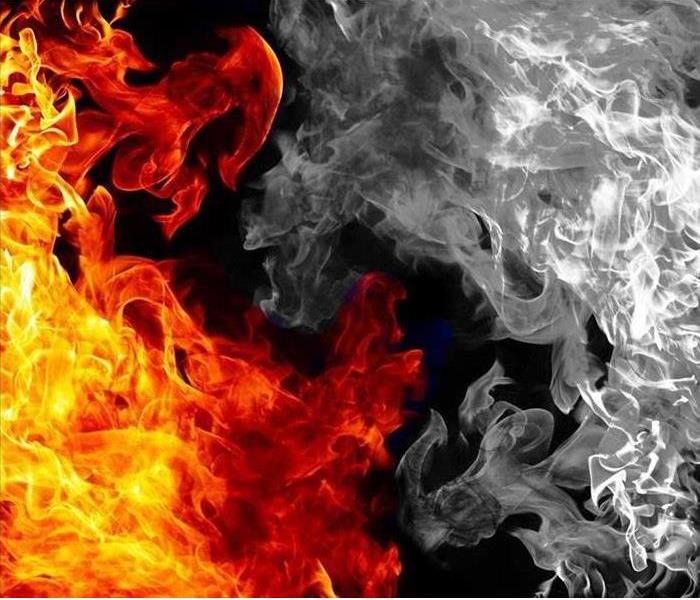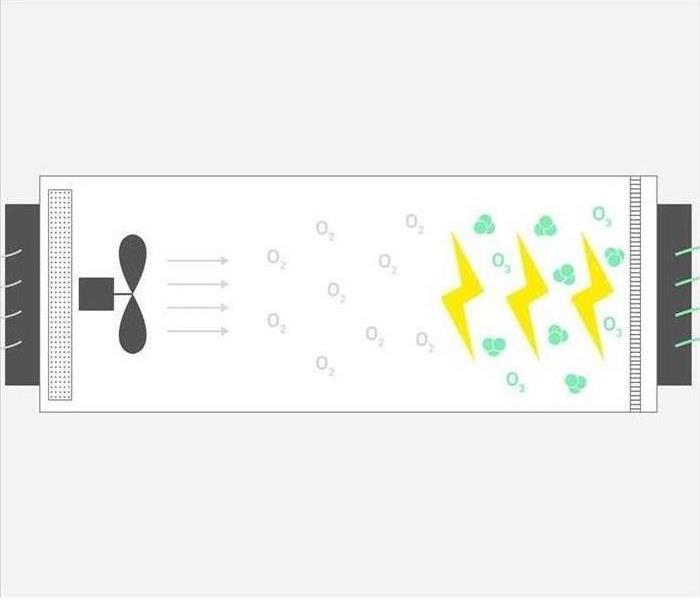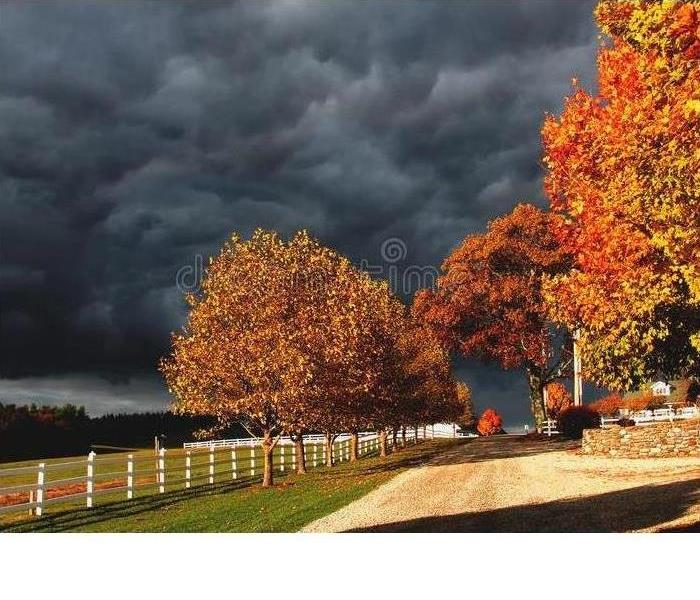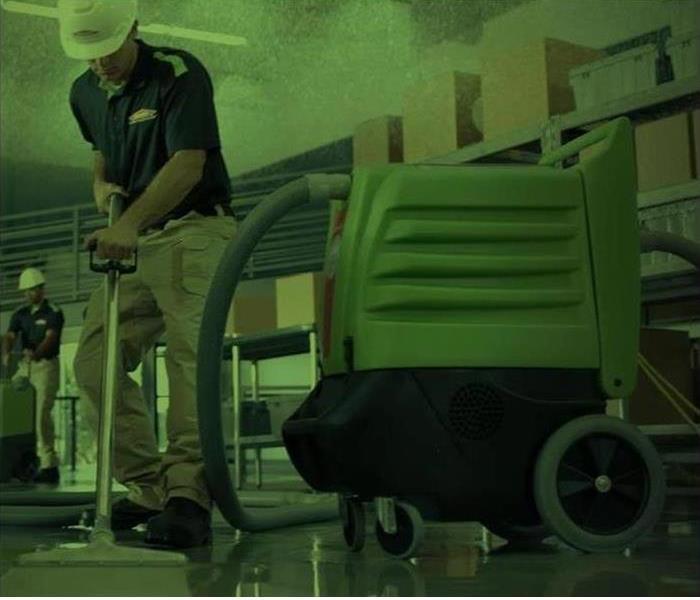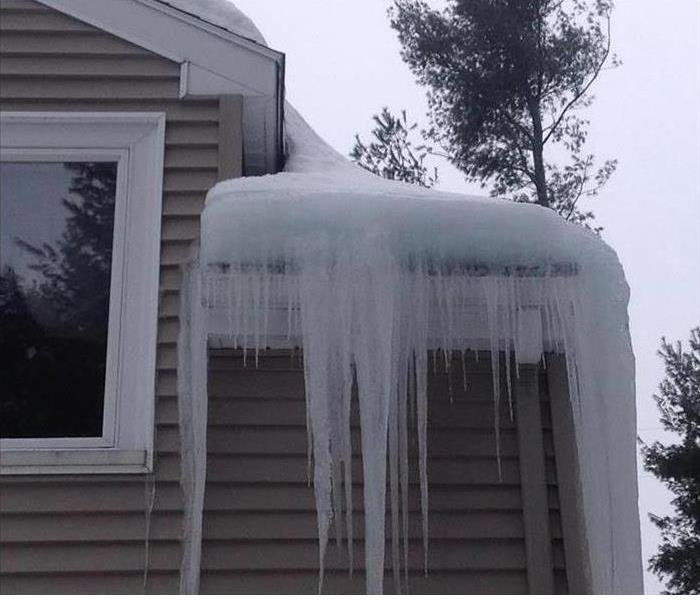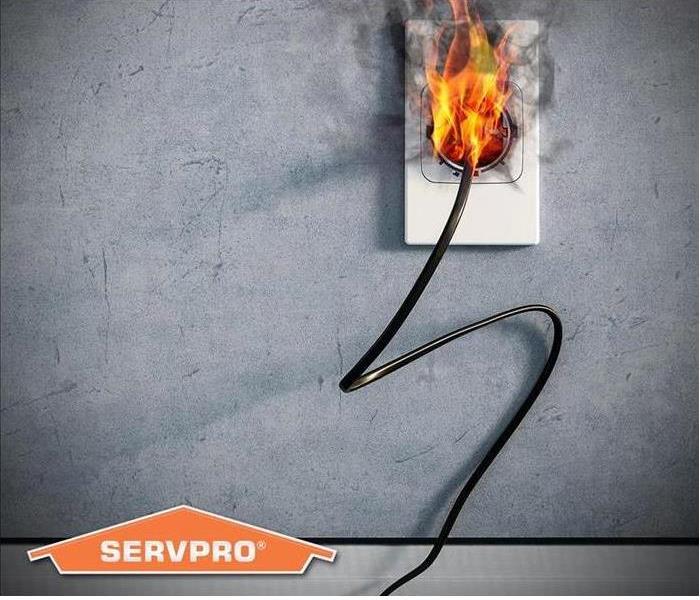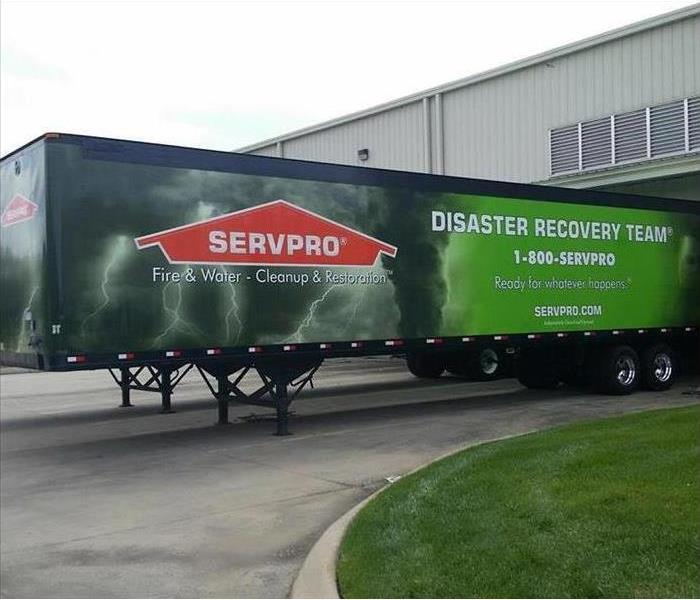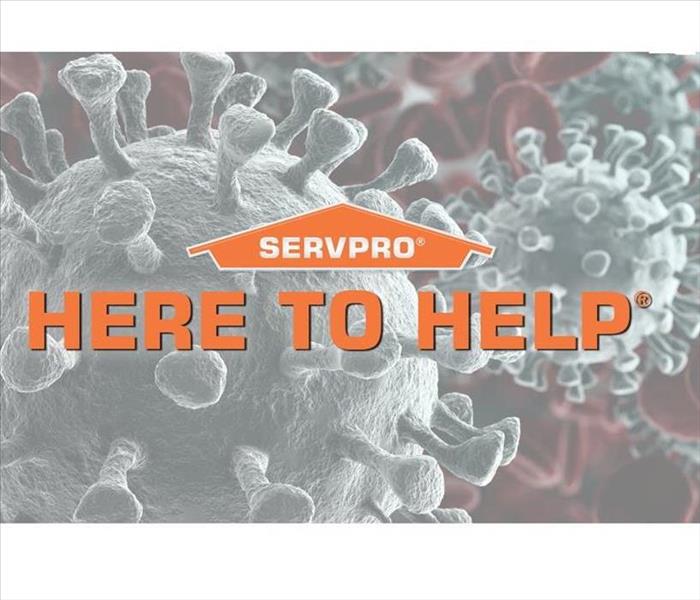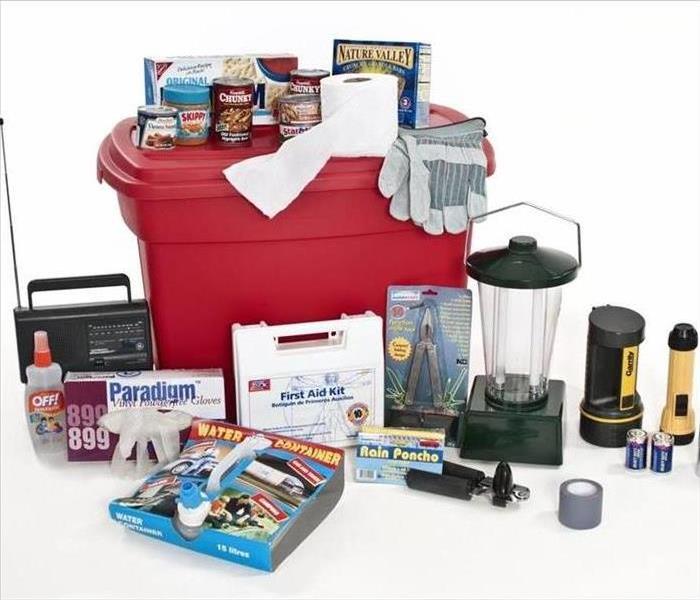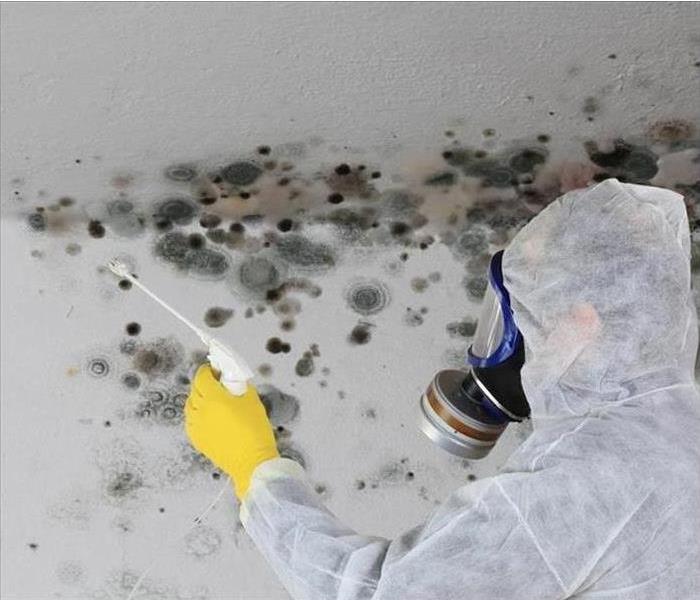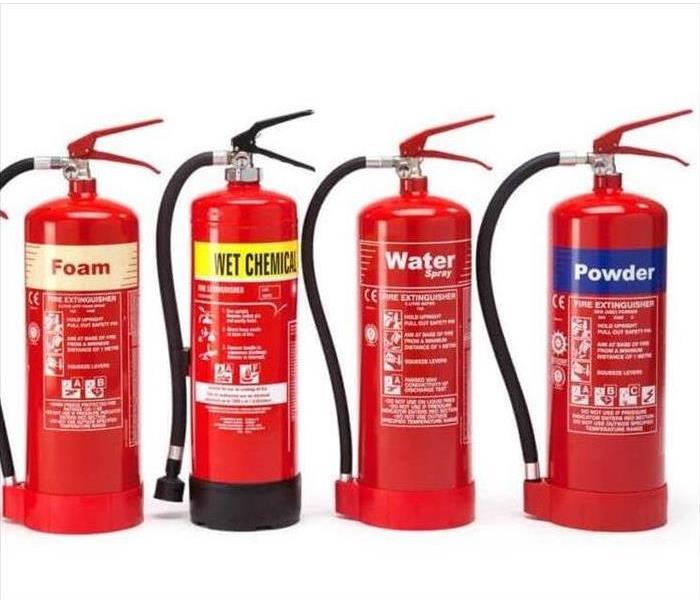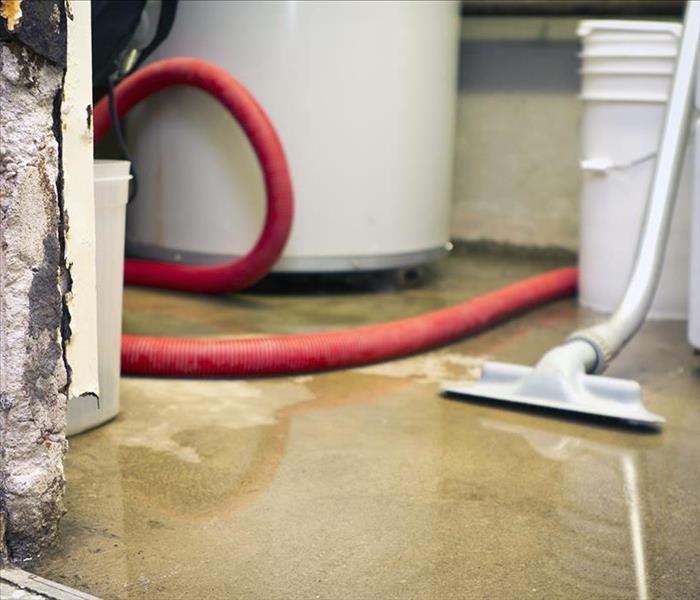Archived Blog Posts
Training Employees for Fire Safety
3/9/2022 (Permalink)
The P.A.S.S Technique
If employees aren't confident they can safely put out a fire, they should evacuate instead. The acronym P.A.S.S. helps employees remember each step of using an extinguisher to reduce fire damage.
- Pull the pin. Find the pin at the top of the canister and pull it out to break the tamper seal.
- Aim the nozzle at the base of the fire. When the source of water is doused, the flames should die down.
- Squeeze the handle to release the pressurized chemicals inside the canister.
- Sweep the spray from side to side, maintaining your focus at the base of the fire.
After working through the steps, keep your eye on the area. If flames reappear, repeat steps 2 to 4.
Annual Fire Response Drills
Use the following steps in case of a fire (and during yearly drills.)
- Pull the fire alarm and alert the fire department.
- Protect the designated evacuation path. If fire, heat, or smoke threatens to come between employees and the exit, personnel should evacuate instead of fighting the fire.
- Choose an appropriate extinguisher.
- Complete the P.A.S.S. technique.
- Observe the location of the fire to catch any flames that may reignite.
- Evacuate immediately if the fire is too big, if the air isn't safe to breathe, if the room is too hot or smoky, and/or if the evacuation path is compromised.
Once the ability to use the fire extinguisher has been mastered and employees have been trained in the fire response routine, schedule opportunities for employees to practice their responses to a fire.
Practice Safety
It doesn't take long for a kitchen fire to pop up in a restaurant or flames to appear in an industrial setting. Protect your employees with training on how to use a fire extinguisher and regular drills in fire safety techniques. Fire damage restoration professionals could provide you with further resources.
Spring Storms Affect the Kearney and North Platte Area
3/9/2022 (Permalink)
Whether it's your home or your business, strong storms can wreak havoc on your property.
Living in the Kearney and North Platte area we have grown accustom to living with the lively weather patterns that the spring season brings.
Sometimes, there's not much you can do to protect your property when 100+ MPH winds hit. Generally, we focus on what's most important... our loved ones. After the storm clouds clear a small percentage of our population will find damage to their homes and businesses.
SERVPRO is prepared to assist after spring storms.
So whether it's a flooded basement in your home, or the entire roof ripped from your building, there's only one call to make. The cleanup professionals at SERVPRO of Kearney and North Platte quietly taking to the streets 24 hours a day, 7 days a week with the best training and equipment. Call us at 308.535.1115
We are prepared to do the hard work necessary to make it "Like it never even happened."
What Are My Options when I Have a Commercial Flood?
11/8/2021 (Permalink)
Commercial Water Emergencies in Kearney and North Platte can occur at any time of the year. Sometimes, you may find yourself unable to trade until the situation is under control.
Can I get a business rate reduction as a result of flooding?
In some situations where water intrusion is beyond your control, you may reduce your business rates. However, the surest way to limit losses to revenue is to take a proactive approach to restoration by enlisting commercial water removal experts in Kearney and North Platte. Using a professional service that has experience working on commercial projects can reduce losses as well as providing you with a precise time frame to plan your business activities. Our crew chiefs can inform you of necessary restoration, possible outcomes, and working closely with local insurance adjusters.
Where can I source water displacement pumps to move water out of my premises?
Local hire centers are available to rent displacement pumps temporarily. However, you should ask yourself whether you or your staff are qualified to set up, pump, and dispose of wastewater correctly. Different types of water damage requires different types of equipment. Water with solid waste requires a pump with unique characteristics. Self-priming trash pumps have the necessary lift, volume, and ducts to transport solid wastes. However, it may be illegal to dispose of solid wastes in a regular sewer point, meaning you also need a means of transport to take wastewater to a facility for disposal. SERVPRO has both the equipment and the expertise to remove water from your commercial property following local and state regulations.
What types of water removal equipment are available to SERVPRO technicians, and what are their uses?
- High-pressure pumps provide significant power to transport water uphill and out of the property
- Self-priming trash pumps are capable of passing water with solid waste up to 1.25 inches
- Electric submersible pumps move from 100 to 18,000 gallons per hour
- Weighted extraction tools for removing moisture from thick fabrics or textiles like carpets
- Light wands which are agile enough to reach areas with space restrictions
How can I choose the right extraction tool for water displacement?
Pumping equipment is the most efficient in terms of a gallon per hour (GPH.) Next, extraction tools that are useful once pumping becomes inefficient- usually once standing water drops below two inches. Dehumidification equipment is the least efficient, and we usually reserve it for drying residual moisture or lowering the moisture content of building materials. There are other considerations when choosing your equipment, such as how far water needs transporting to reach your sewer points or storage tanks. A distance of more than twenty-five feet usually requires a high-pressure pump to displace water efficiently.
Does my business insurance cover mold growth?
It is essential to check your insurance policy to be sure of your coverage. Commercial properties usually cover flooding under a separate policy to business insurance. Equally, mold growth is usually only covered if the mold is the direct result of the water intrusion. Crucially, if mold occurs after the event, property managers must prove that appropriate mitigation efforts take place. Our water damage restoration (WRT) technicians can take steps to reduce the likelihood of mold growth. These include maintaining control over relative humidity throughout the service using thermal hygrometers. We can also take precautionary steps to prevent mold growth by applying anti-microbial treatments in the affected area.
What are the necessary steps to take when there is water intrusion at commercial premises?
- Contact your insurance provider to notify them of the situation
- Reach out to professional restorers as soon as possible- our emergency call-lines are in operation twenty-four hours a day.
- Use local companies to reduce call-out times- we promise to arrive within four hours of notification of loss.
- Wait for crew chiefs to arrive who can communicate closely with both you and your adjuster
When is it safe to reopen my business after a commercial water emergency?
A business is safe to reopen once it returns to a sanitary state. Water can carry microbes into premises, which can cause health and safety concerns. Our team can not only remove the body of water from your property but can also clean, dismantle, and reassemble the affected area. We are using chemical agents that can kill any potential microbial growth, which may include bacteria, fungi, or viruses. Once the property is thoroughly decontaminated and dry, our crew chief can perform a walkthrough. The walkthroughs occur once the restoration is complete, and we can pass on any paperwork to your insurance provider to complete a stress-free claim.
If your business requires emergency water recovery, our commercial teams are available. Contact SERVPRO of Kearney and North Platte at (308) 535-1115.
Back to Business!
11/8/2021 (Permalink)
The restoration and recovery of a water loss in your office happen in phases. Should disasters strike during working hours, you need to find a suitable solution that can keep your facility open to your customers until restoration work can safely begin. A prompt response with our emergency services, including extraction and controlled demolition, can allow the business to remain open until the workday ends, and our SERVPRO technicians can get to work on restoration.
Emergency repairs do not fully resolve the water damage to your offices, and often the full recovery of your property involves the use of many restoration tools, machines, products, and techniques. A priority of our rapid response team arriving at your office building is determining the source of the water damage and addressing it whenever possible. Ruptures to the plumbing after pipes freezing or a broken faucet might allow for substantial water depositing on the floors, and require repair before extraction and drying efforts can be practical.
At first, repairs to the plumbing can begin when our in-house contractors arrive at the office building. Because there are so many desks and other furniture that can get saturated by standing water concerns, extraction is also a vital element to the pre-restoration process. With the appropriate containment strategies in place to encase the drying zones like the damaged bathrooms, we can work to keep your office open until closing time.
While the full measure of restoration work does not begin when our rapid response team first arrives, preliminary actions can reduce total property loss. With efficient drying tools like our air movers and dehumidifiers, we can make short work of compromising water loss effects.
The recovery of your office building, including the containment of the source of the water loss, involves a combination of our experienced SERVPRO of Kearney and North Platte technicians and in-house commercial contractors. From our emergency response to our tireless work to get your doors back open, it is our business to get you back in business. Give us a call at (308) 535-1115.
Is Your Carpet Ruined After a Flood?
11/8/2021 (Permalink)
Floods can bring contaminants, dirt, and soil into your home. Even after removing the standing water and drying a property, these stains can remain on surfaces, particularly those porous materials like carpets.
Performing flood damage restoration in Nebraska area home relies on expertise and effort. SERVPRO technicians are trained to recognize different carpet damage types from absorption to agglomeration and water exposure. Using tried and tested methods, we can often return carpets and textiles to an original condition. At the end of service, one of our crew chiefs can guide you through the property to explain the outcomes of restoration and effective restoration of materials.
- Burn tests and chemical tests are performed as standard to avoid further damage.
- Our hot water extraction techniques are effective at removing soils from carpets, textiles, and other porous materials.
- Roto machine buffering can restore the luster of wet carpets in the property.
Restoring rather than replacing materials is more cost-effective. Contact SERVPRO of Kearney and North Platte for flood damage restoration at (308) 535-1115
How Landscaping Can Help Slow Flood Damage
11/8/2021 (Permalink)
Have you ever seen a school science demonstration of water being poured into two equal containers of soil, but one has plants growing and one does not? In the box void of vegetation, the water runs out the bottom nearly as quickly as it flowed in. In the box containing rooted plants, only a minimal amount of water trickles out. This experiment shows the importance of proper water management around your property. Learn how you can become one with the flow, using easy landscaping projects to prevent storm run-off from causing outside flooding around your home in the Kearney and North Platte area.
- Slow the flow. Apply a deep layer of heavy mulch to slow rain drainage, giving it time to filter through the soil instead of pooling or running off to problem areas.
- Cultivate plants. Installing plants and shrubs at the base of your home can help slow the flow of water and prevent outside flooding. If you have a particular area where water tends to pool during storms, consider making a rain garden. This shallow basin is not a bog or a pond, but it uses plants to filter the rain water and facilitate its travels to the water table.
- Be a water mover. During the next rain storm, check the flow of water from your roof. Look for areas that need rerouted and consider adding rain chains, moving gutters, or adding flexible extensions to downspouts to direct water away from your foundation.
- Keep water captive. Add a rain barrel to the end of a downspout and feel good about your impact on the environment when using that recovered water to help take care of your plants.
Outside flooding can cause damage to structures on your property.
When water damage happens, it can quickly lead to mold trouble since mold spores are abundant in the environment and reproduce quickly. Professional water mitigation specialists can help clean up flood water and ensure materials are dried thoroughly to prevent your minor problem from becoming a major one.
Continuing Education Classes
11/1/2021 (Permalink)
SERVPRO of Kearney and North Platte offers both credit and non-credit courses for insurance agents, insurance adjusters, and Real Estate professionals. Our offered Continuing Education (CE) Courses provide you and your employees with information that will allow you to better service your customers.
These programs are designed to improve the knowledge of your staff regarding emergency mitigation. Our franchise has held Continuing Education Courses on various topics including:
- Biohazard Cleanup
- Understanding Mold in the Restoration Industry
- Restorative Drying for Water Damage
- Mitigation Awareness Response Seminars
- The Hazards of Hoarding
Our upcoming CE Course will be December 9th through our zoom link.
"Ethics"
The premise for this ethics course is that although we may have solid ethical foundations and usually make rational ethical decisions, ethical lapses are likely to come when we are stressed, angry, upset, worried, or otherwise disengaged. Each and every day we are faced with decisions that could cause harm to others or ourselves. Facing ethical decisions can be very difficult, especially when we make decisions that may seem correct at first, but we later find out were not so great. As we explore what "Ethics" is, you will be challenged to become involved in group activities. The group activities will help reinforce what has been learned, as well as increase your ability to better deal with ethical decision-making in your own life.
If you have any questions, please contact Nathan Koerner at nathan@goSERVPRO.com or give him a call at 712-253-3852
Reviews and Why They Are Important
11/1/2021 (Permalink)
SERVPRO of Kearney and North Platte has been restoring homes and commercial properties for sometime now.
SERVPRO strives to provide the highest quality and efficient work possible. No matter what your expectations are for fire and water damage, mold remediation, or COVID-19 cleaning, we strive to exceed them.
This is where YOU come in.
As a customer, we understand that you want to know how great the technicians are at SERVPRO of Kearney and North Platte.
Check out our current testimonial page for a vast representation of what our customers think about us.
Have you been serviced by SERVPRO of Kearney and North Platte but haven't left a review yet?
Whether we provided our restoration or remediation services a year ago or yesterday, there is still more than enough time to write about your experience.
We want to know what you think about our services so we can continue our high quality and efficient work!
Have Questions? Call Us Today: 308-535-1115
How to Avoid Frozen Pipes
11/1/2021 (Permalink)
Once the summer temperatures fall and cooler weather settles in, there are many possible causes of water damage for business owners to consider. One of the most important situations to avoid is the damage that happens after freezing temperatures lead to broken pipes.
Prevent Frozen Pipes
Before jumping into the steps to take after the damage has happened, consider some steps you can take to protect your pipes and, hopefully, prevent them from breaking:
Identify areas of possible weakness, such as pipes that are exposed to the weather, pipes in unheated parts of the building, and unprotected pipes along exterior walls.
Drain water from hoses and pipes that won't be used during cold weather, such as the sprinkler system.
Remove exterior hoses and store them inside. Drain hoses and pipes before storing them for the winter.
Add insulation to exterior walls, basements, and other cold rooms in the building.
Consider products such as pipe sleeves and insulated covers. These protective covers could provide just enough warmth to keep water running when it's needed.
Remember that water expands when it freezes, so when the water in a pipe becomes cold enough to freeze, there's a lot of pressure from the inside of the pipe. The steps you can take to prevent broken pipes are effective ways to avoid a lot of water damage.
Keep Your Pipes Warm During the Winter
There are several other steps you can take to protect your commercial property in the Kearney and North Platte area. These include setting your nighttime thermostat to a temperature above freezing, letting a small amount of cold water drip from the faucets during very cold weather, and opening cabinet doors to allow heated air to flow freely around the pipes. If your business is going to close for several days or longer, turn off the water to the building. Otherwise, you may return to serious flooding and the need for expensive water cleanup.
Respond to Frozen Pipes
Sometimes, in spite of your efforts, the pipes may still freeze. Even if there's no obvious damage, you may find that just a small trickle is all you're getting from the faucet. This is a clear sign that the pipes are frozen:
Leave the faucet open and begin looking for the section that's frozen.
Use a space heater, electric heating pad, or another gentle source of heat to treat the frozen section of the pipe. You could also warm up some towels to wrap around the pipes. As you slowly thaw the ice inside the pipes, you'll see a stronger flow of water from the faucet. Don't ever use any open flame, blowtorch, or propane heater to warm up the pipes.
Continue applying gentle heat until you have full water pressure from the faucet.
If you have one frozen pipe, there's a good chance that there are other clogged areas in the pipes. Test all of the faucets on your property.
If a burst pipe has caused serious water damage, contact local cleanup and reconstruction professionals. The sooner you respond to flooding and damage, the better you can avoid further expense and inconvenience.
Water in a Light Fixture?
11/1/2021 (Permalink)
A flood from a busted pipe or supply line leak can affect more than just the surrounding area. This is particularly common when the faulty water source is on the second story of your home in the Kearney and North Platte area. Not only can it cause water damage to the flooring and walls around it but also to the ceiling under it. Here are a few tips for getting the water out of the light fixture on your lower floor effectively and efficiently.
2 Tips To Deal With Water in a Light Fixture
1. Stay Safe
Your gut reaction may be to open up the fixture and just let the water drain out. This is not advisable until you have taken the necessary safety precautions:
- Shut off water to stop flooding.
- Flip breaker to cut power.
- Don rubber gloves and boots to neutralize residual charge.
Draining the fixture is one of the first steps toward taking care of the water damage to your lower floor. If you choose to touch the light before the restoration team arrives, make sure you are doing it safely.
2. Call Professionals
If the leak in your home has flooded two floors, you need water damage repair that goes beyond amateur abilities. When water has made its way into a light fixture on a lower level, you probably have quite a bit of ceiling damage on top of everything that needs mitigation on the higher floor. You need a team that has the experience and expertise to address the whole problem. As soon as you know there is an issue, call local water restoration specialists. They can assess the problem, propose solutions and provide an estimate of how much time and money it will probably take to fix it.
Water damage doesn't always stick to one area of your home. The more water involved, the farther and faster it can spread. It may even flood a lower floor, including the ceiling and light fixtures. Use the appropriate safety precautions and call for the help you need.
Kids and Fire Safety
11/1/2021 (Permalink)
As a parent, your kids' safety is likely the number one priority on your list. Therefore, it just makes sense to have a simple escape plan that they can remember so that they can get out of your house in the Kearney and North Platte area quickly in case of a fire. Here are a few things to teach them to ensure they know the drill.
Teaching Fire Safety to Kids
How To Get Out of the House
The smoke detector is probably the first indication that there is a home fire. When your kids hear this, they must know the steps to take to get to safety:
- Bed roll - Instead of sitting up in bed, roll to their stomachs and use the hand closest to the side to guide them to the floor.
- Floor crawl - Crouch down on hands and knees or on their bellies if smoke and heat are already in the room and crawl toward the escape.
- Test door - Touch door to see if it's still cool and if so, open slowly to see if it's safe to crawl out of the room.
Practice doing these things with your whole family so that everyone can be familiar with what to do in the event of an emergency. Your kids' safety may depend on their ability to get out of the house on their own, and these drills teach them how to do that.
How To Find Each Other After Escaping
You also want your kids to know where to go after they get out of the burning house. Fire restoration experts recommend that include a safe spot where you will meet if you get separated in your fire escape plan. A trusted neighbor's house or a well-lit parking lot of a business down the street are both good options.
Knowing what to do when there's a fire is important for everyone in the family. Protect your kids' safety by teaching and practicing the plan until they are comfortable with it.
Firepits and Safety
10/12/2021 (Permalink)
Now that it’s becoming cooler outside, many of us are uncovering our firepits and looking forward to spending time gathering around them to enjoy time with family and friends. Practicing fire safety is going to be an important thing to remember.
Let’s have a quick refresher on how to safely use your firepit:
Whether you prefer a built-in or portable fire pit, choose one that is not too large for the area. The pit should be a minimum of 10 feet away from any structures or combustible materials as well as away from trees, fences, sheds, power lines, and telephone wires.
Make sure that the seating area is large enough and properly placed for comfort and ventilation.
Don’t start your fire if it’s really windy; a strong breeze can easily blow sparks onto nearby flammable materials, such as firewood piles or roofs, and can hurt people, too.
Burn only dry material. Damp material will create excess smoke.
Don’t use lighter fluid or gasoline to get your fire going as it can easily burn out of control or even result in explosions. Don't burn tires, aerosols, fireworks, or anything containing paint or foam to avoid toxic fumes which could also explode and cause injury.
To start the fire, use a lighter to ignite crumpled pieces of paper covered with small sticks. Then, add larger sticks and a log or two to keep it burning.
Wear non-flammable clothing and hard-soled shoes when starting, sitting near, or extinguishing the fire.
Never leave the fire unattended, and keep pets and children far away from the fire as they will be attracted to it.
Keep the proper fire extinguishing equipment, or at least a water hose, handy in case there is an emergency. You could also fill a bucket with sand, which can be used instead of water to help extinguish a fire.
As the fire dies down, use a shovel and spread out the ashes to allow them to cool down. Then slowly pour water over those ashes and watch them closely to be sure that no burning embers remain or reignite. Put the cooled ashes in a specially designated ash storage metal can.
SERVPRO of Kearney and North Platte is dedicated to providing the quickest response to any fire event that may occur in our area. Immediate action is crucial to limiting the damage, and we have a trained and experienced team, along with the specialized equipment necessary for prompt recovery and restoring your home or business. Reach our office at 308-535-1115 for any questions regarding smoke or fire damage.
Preventing Lightning Damage
10/12/2021 (Permalink)
According to the National Fire Protection Association (NFPA), lightning strikes were the cause of an estimated average of 22,600 fires each year, that’s a lot of fire! With some homes being struck in last night, it’s important to know about the options for your home when it comes to lightning safety. Although the chances of your home getting struck by lightning is fairly slim, it can happen. It’s hard to predict mother nature, and what she is going to do, which is why you can install preventative measures to your home to make sure that a fire does not get started because of a lightning strike.
For example, you can hire a company to come out to install copper tubes on the top of your house, which will distribute the current away from your home and into the ground to prevent fires. If you’re worried about the aesthetic of your home – after all, who wants big copper poles sticking out of the top of your home? Don’t worry! They only come up about a foot off the top of your roof and are unnoticeable. In the long run, it’s a great investment to keep your home safe.
If you’ve been affected by a recent fire, give us a call today at 308-535-1118
When to Replace your Roof
10/12/2021 (Permalink)
When it comes to knowing how often you should replace your roof, there really isn’t any hard and fast rule. You have to keep an eye on its condition to be able to tell if you need to start thinking about it. If your roof is showing signs of damage, that could lead to major water or storm damage to the rest of your home. Our team wanted to share a few potential issues your roof may develop; any one of these may mean it’s time to replace your roof.
Age
An asphalt shingle roof should last between 20 and 30 years, so if you have a 40-year-old roof, just keep in mind that you will probably need to replace it entirely in the next 1-5 years.
Shingles
Shingles can curl in two ways: by “cupping,” which happens when the edges of the shingles turn upward; and “clawing,” which is when the edges stay flat and the middle starts to come up. Both are signs of weathering and indicate that potential leaks may possibly be developing, depending on the extent. Every homeowner finds themselves replacing a missing shingle, but it can be just about impossible to get a new shingle to match the color of an old one. Granule colors have changed pretty significantly over the years, and shingle colors often change with years of weathering. If your roof is starting to look like a patchwork quilt, you may want to consider replacing it soon.
Damage
Cracked shingles are typically caused by wind damage, and if the damage is extensive and not isolated to just one area, you should start thinking about replacing your roof within the next few years.
Algae Or Moss
This is not a big deal when it shows up on your roof, but it doesn’t give your home or business a great look. You don’t want to take matters into your own hands by power washing or scraping it away since that will often chip off all the protective granules and essentially render your shingles useless. You can use a wash that's one part bleach and one part water to remove algae or moss, and if you do decide to replace your roof, consider tiles that are algae-resistant.
Light
This issue is pretty obvious: if light can get in through your roof, so can rain. If you see any water stains during the next rainfalls, and if they spread or expand, you have an active leak, and it is time to contact SERVPRO of Kearney and North Platte immediately to help remediate the water damage and potential mold growth.
Sagging
A sagging roof is typically an indication of a structural issue and demands immediate attention. There could be a problem with the decking in the attic or with the supports in the foundation, which is even worse. You're not necessarily in imminent danger, but this is the kind of thing that's a lot easier to take care of when it's small and localized, so call your roofing professionals right away for this roofing issue.
When it comes to replacing your roof, there is no hard and fast rule. If you are experiencing water damage, it is probably time. Remember that SERVPRO of Kearney and North Platte is here to help if you are dealing with water damage, fire damage, or a mold infestation.
Get Rid of That Nasty Mess!
10/12/2021 (Permalink)
SERVPRO of Kearney and North Platte provides biohazard cleanup services for the following:
- Hoarding situations
- Animal remains/Waste
- Viral pathogen/Coronavirus
- Sewage backups
- Unattended Death/Suicide
- Homicide
- Crime scenes
- Tear gas
- Meth lab
- Blood and body fluids
Common Biohazard Problems
Sewage Backups
Sewage backups and dark water intrusions are more than nasty, smelly deposits – these damages also introduce harmful microorganisms into a structure. SERVPRO franchise professionals remove the sewage, contaminants, and moisture, and help ensure the structure is properly cleaned, disinfected, and deodorized.
Bloodborne Pathogens
SERVPRO of Kearney and North Platte professionals remove and dispose of bodily fluids, tissue and other substances resulting from death, trauma, accident, or crime. Trained SERVPRO of Kearney and North Platte professionals clean, disinfect and deodorize the structure.
“Meth” Labs
SERVPRO of Kearney and North Platte professionals follow state and federal guidelines to properly clean all surfaces. Many of the chemicals used in the production of illegal drugs are volatile and can leave harmful residues.
Cleaning vs Disinfecting at Home
10/4/2021 (Permalink)
Many think cleaning and disinfecting are synonymous but there is a crucial difference between the two. When you clean, you’re simply removing organic dirt, debris, and general soils. Disinfecting is using a higher level of disinfectant product to remove or control the spread of viruses and bacteria. Disinfection isn’t as effective, though, if you don’t clean first prior to applying the disinfectant product!
Follow these 5 tips from our SERVPRO experts to make sure you’re properly protecting yourself and your home.
1. USE EPA REGISTERED DISINFECTANTS
There are consumer products out there that are almost as effective as professional products in the fight against the spread of infectious diseases when used according to the label. All these products are going to be registered by the EPA and will have specific directions on how long the surface must remain wet, how the product should be applied, and what surfaces they can be used on.
2. FOLLOW THE MANUFACTURER’S INSTRUCTIONS
You can have the best cleaning product, but if you don’t know how to apply that product correctly, you’re going to be ineffective. Disinfection can be done effectively at home if you use the right products and follow the label and product instructions.
3. PROTECT YOUR HANDS WITH GLOVES
Basic hand protection when using disinfecting products is always wise. Try to use nitrile gloves or any other type of disposable gloves you can find.
4. USE A MICROFIBER CLOTH, NOT A SPONGE
Microfiber cloths are made up of fibers with multiple surfaces and allow you to have a better contact as you’re cleaning. Household sponges are not recommended, as they can often be breeding grounds for bacteria. If possible, you could even use something that you can dispose of, like disposable wipes or cloths. Otherwise a microfiber cloth is what you should use.
5. CLEAN HANDS AND SURFACES REGULARLY.
Keep your hands washed and regularly clean high touch areas in your home like door handles and light switches. Practicing basic hygiene is what’s going to continue to break the cycle of infection and reduce the virus spread.
Putting these tips into practice can help you reduce levels of contamination.
Tips on Reopening Your Business After a Disaster
10/4/2021 (Permalink)
A natural disaster can occur at a moment's notice. Within seconds, your business can be damaged or destroyed, forcing you to close your doors until you can get back up and running. Unfortunately, businesses that haven’t implemented a disaster recovery plan before the unthinkable happens may likely be unable to reopen their doors after a loss. In fact, according to the Federal Emergency Management Agency (FEMA), up to 40 percent of small businesses never reopen their doors after a natural disaster strikes. With lack of planning for financial damages, property destruction, loss of essential business documents and equipment, and taking care of staff needs, it can be difficult for business owners to rebuild when disaster strikes.
Luckily, the experts at SERVPRO are here to help. Use these tips to get your business back on its feet as soon as you can after disaster strikes.
CREATE A DETAILED NATURAL DISASTER PLAN
If your business is going to survive a natural disaster, you’ll need a detailed preparedness plan in place. Write down a list of immediate solutions you'll implement in the aftermath of a natural disaster. Include items such as:
- Which disasters are likely to impact your business, depending on where it is located
- Locations suitable for employee evacuation
- How to stay in contact with all staff members
- Emergency contact information for each employee
- Plans to protect and/or access vital business records and information
- If there will be an off-site location from which employees need to work until doors reopen
- Contact information for the business’s insurance company, financial institutions, and a reputable disaster restoration company
KEEP LINES OF COMMUNICATION OPEN
As soon as you can, keep your customers and staff informed about what's happening with your business. Provide an estimate of when you'll be able to reopen for business. If excessive damage forces you to temporarily relocate, let others know how to find you. Keep in mind that your ability to recover from a natural disaster might largely depend on how quickly your employees are able to return to work. Reach out to your team, and work with them to make scheduling changes if necessary so everyone can get back to normal as soon as possible.
SEEK OUTSIDE HELP
While FEMA provides financial assistance to businesses that are located in a federally declared disaster area, the process of receiving aid can take some time, especially when an astronomical number of claims are being filed. Have a backup plan in place to ensure you're able to cover the costs of repairs in a punctual manner.
Consider purchasing a flood insurance plan that specifically covers natural disasters. The Small Business Administration (SBA) may also be a good place to turn for help. Through the organization's Office of Disaster Assistance, businesses that are located in declared disaster areas can apply for low-interest, long-term loans to make repairs and replacements.
SET YOUR BUSINESS UP FOR A QUICK RECOVERY
Even just one act of nature can cause a major interruption. Businesses that recognize the importance of having a detailed plan in place to recover after a natural disaster may have a greater chance of survival. Start listing out your steps to rebuilding before disaster strikes to increase your chances of recovering.
If the unexpected does happen, remember that you’re not alone. Count on the experts at SERVPRO to guide and support you throughout the recovery process and help get your business back up and running again as quickly as possible.
Flooding and your Business's Electronics
10/4/2021 (Permalink)
If you're like most business owners, your office electronics are the lifeblood of your company. In the event that a disaster strikes, all your records could be impaired and permanently lost, including invaluable company records, customer information, and even communication.
In the aftermath of a flood, it's important to know what to do to mitigate the effects of water damage on your computer systems and other electronics. If you act quickly enough, you may be able to save more information and get your business back on its feet faster. Find out what you should do after an emergency and when to call on the professionals after your equipment or technology has been damaged by high humidity, directly hit, or completely submerged in water with these helpful tips from SERVPRO.
DAMAGE TYPE: HIGH HUMIDITY
Humidity spikes can occur in a room with standing water or other significant water damage. Surprisingly, delicate electronics like computers, printers, work phones, fax machines and other devices can still be damaged even without direct contact to the water source. That's because in humid conditions, dust can turn into sludge and cling to wiring and circuit boards. This is even more likely if the flooding or high humidity was caused by an office fire that produced smoke damage to electronics.
What to do: In all instances of high humidity water damage, professional electronic restoration services are recommended to bring your equipment back to normal conditions. A professional cleaning provides a better chance that your costly electronics and devices can be fully restored to preloss condition.
DAMAGE TYPE: DIRECT HIT
Electronics can sustain a direct hit from running or splashing water without being completely submerged. This scenario can occur from accidental spills, water overflow, leaks, floods and virtually any other water-related incident. When direct hits to your electronics happen, try to remove them from the water source as soon as possible to prevent permanent damage.
What to do: Often, computer water damage from a direct hit looks worse from the outside than it actually is on the inside. Commercial restoration and cleaning, including an adequate drying period, can remove contaminants left by the water and restore the equipment to proper functioning, usually at least long enough to recover crucial data. However, there is always a risk of circuit board corrosion. Over time, you may need to replace either essential components, or the entire device.
DAMAGE TYPE: SUBMERSION
Submersion occurs when the electronic equipment has actually been completely covered in standing water – and possibly even muddy silt and sediment – for a period of hours or days. This type of damage can happen in serious disasters where people are unable to get to the office for long periods of time, or during weekends or holiday breaks when a pipe may burst and nobody is notified until the next business day.
What to do: Unfortunately, electronics that have been submerged are not usually good candidates for electronic restoration services. This is because most submersion incidents cause the computers to short out and damage the internal circuits beyond repair. While you could potentially replace damaged parts and have the equipment professionally cleaned, it may be prohibitively expensive unless your items were specially designed or extremely costly. In submersion cases, we recommend completely replacing your electronics and notifying your insurance about each damaged item.
Remember, if your business has sustained flood or water damage, it is never safe to just turn on your electronics afterward to test them. You run the risk of electrical shock, and even further damage to your equipment. That's why you should call on us. Our water damage restoration services work quickly with the innovative tools and expertise necessary to fix your equipment. Contact the professionals at SERVPRO to learn how we can get your business back up and running fast.
Getting Your Business Up and Running After a Hurricane
10/4/2021 (Permalink)
After any severe natural disaster, many people are left wondering how to even start picking up the pieces, both literally and figuratively. If you’re a business owner, you not only have to worry about repairing your home, but also your commercial property – your livelihood. If your building experienced severe water damage, use these hurricane damage recovery tips from the experts at SERVPRO to get your business up and running as soon as possible.
FIRST THING'S FIRST: STAY SAFE
Safety should always be your number one priority – business owner or not. Even after the rain stops and the flood water begins to recede, the dangers of flooding still loom. You may not be able to see potential electrical hazards, gas leaks and water contaminants with an untrained eye, which is why you should avoid entering your property until an inspector determines the structure is safe.
STEPS TO RESTORE YOUR BUSINESS AFTER A FLOOD
After you're given the OK to reenter your place of business, follow these five steps to safely examine the damages and start your commercial property's recovery and restoration.
1. Contact Your Insurance Provider
Begin the claim filing process for any major damages as soon as possible. We know that dealing with insurance can be a long, frustrating and daunting process. That's why it's best to place a call to your insurance agent right away. You can always call back with more details on the damages later, but the sooner you start, the better.
2. Wear Safety Gear
If your property survived the storm, it may have some battle scars. Since there will likely be debris, broken glass and flood water inside, you'll need to wear the proper protective gear during cleanup, including gloves, closed toe shoes and possibly waders. Try to cover any exposed skin to reduce the risk of scratches, cuts and infection.
3. Survey the Damage
Seeing your business damaged by a flood can be devastating. It's OK to feel sad or overwhelmed – in fact, it's completely normal. Take you time to process the extent of the storm's impact. As you assess the scope of the damage, remember to take pictures of any damage you see and to make detailed notes for your insurance claim and company records.
4. Clear Rubble and Salvage What You Can
Remove unharmed or repairable items and store them in a safe, dry place until the restoration of your building is complete. If the rest of the debris is safe to handle, clear away rubble so you can begin repairs. Make any minor fixes if you can, but don't be afraid to ask for help.
5. Find the Right Professional Help
Flood damage restoration experts know how to tackle jobs of all sizes and get your business back in shape quickly. Find a company like SERVPRO, who can guide you through the entire restoration process and have proven experience helping businesses recover after hurricane flood damage.
Stopping a Water Leak Before it Becomes a Problem
10/4/2021 (Permalink)
A water leak in your business should never be ignored. Whether from a plumbing leak, an appliance malfunction, or a leaky roof or windows, even a small amount of excess water can lead to significant water damage repair costs. That’s why it’s important to identify leaks and take quick action to correct them. Use the following tips from SERVPRO to stop small leaks from becoming a big problem.
HOW TO SPOT SIGNS OF A PLUMBING OR ROOF LEAK
Water can get into your building in a variety of ways, and two of the main culprits are roof leaks and plumbing leaks. One of the tell-tale signs of a leak in your plumbing system is an unexpected increase in your water bill. If your water bill seems high, inspect your building for the following:
- Leaking pipe joints or P-traps underneath sinks.
- Leaks around appliances that use water.
- Corrosion on supply lines to appliances and fixtures.
- Stains below supply line connections.
- Broken toilet tank flappers.
- Odd smells coming from drains, which may indicate a sewer leak.
- Warped or discolored flooring.
- Water stains on the walls and ceilings directly below bathrooms.
Water stains on walls and ceilings can also be indicators of a roof leak. Other signs of water damage can include a musty smell in the attic, peeling paint around skylights, deteriorating drywall, missing or damaged shingles, and damaged flashing.
WHAT TO DO IF YOU FIND SIGNS OF WATER DAMAGE
Some leaks are, thankfully, fairly easy to fix. A leaky toilet may just require a new flapper valve, while a leaky faucet could need a new O-ring. If the leak requires more than a simple fix, however, call in a professional to address the issue and keep your water damage repair costs to a minimum.
In the event of a plumbing or appliance leak, you can mitigate the damage while you wait for the professionals to arrive. Start by shutting off the local water supply at the site of the leak. Here are the usual shut-off valve locations for some common fixtures and appliances:
- Sink: Just below the sink, next to the water supply lines. Sinks will typically have two shut-off valves, one for hot water and one for cold water.
- Dishwasher: Also under the sink, likely close to the sink shut-off valves.
- Toilet: Close to the toilet and near the floor, as part of the water supply line.
- Refrigerator with water and ice dispensers: On the supply tube running to the refrigerator, likely behind the refrigerator or under a nearby sink.
You can also lessen the potential for long-term damage by mopping or soaking up any standing water in the area of the leak. Keep in mind, however, that where there’s a water leak there’s often mold growth, so if you discover a mold outbreak it’s best to leave cleaning and remediation up to the experts. A professional water damage cleanup service like SERVPRO will know exactly how to address the problem before it gets worse.
Even seemingly insignificant water leaks can be signs of a larger issue. Don't let these problems continue unaddressed. Take steps to identify and stop water leaks at your place of business, and then contact the remediation experts at SERVPRO to make sure your business stays safe and clean for everyone who walks through the door.
Fixing a Running Toilet
10/4/2021 (Permalink)
You’re probably familiar with that notorious sound that emanates from a constantly running toilet. While certainly annoying, a toilet that runs continuously can also be costly in many ways. From a huge water bill to potential flooding or a damaged septic system, running toilets are often more than just a nuisance.
It’s important to know what causes a running toilet, and what you can do to fix it before it becomes a much more serious problem. Read on to find out the basics of toilets that run too frequently, and why this is one repair you definitely don’t want to put off.
What Causes a Running Toilet?
A constantly running toilet is generally an indication that one or more internal components of the toilet tank has malfunctioned. Luckily, these issues can be easy to diagnose, and fixing a toilet that runs is something you can often do yourself. Remove the lid from the tank and inspect the following:
- Fill Valve or Ballcock: Your tank will include either a cylindrical fill valve or a round ballcock that is designed to shut off water flow once the tank has filled up. If water is continuously escaping down the overflow tube, you may need to adjust the fill valve or ballcock to reduce the amount of water it allows into the tank.
- Flapper: This part creates a seal around the flush valve, through which water flows into the toilet bowl. Ensure that the flapper is not worn, chipped or hardened. Make sure the chain coming off the flapper has not gotten caught or tangled, and that it has adequate slack to allow the flapper to close automatically after the handle is released.
- Flush Valve: Like the flapper, this part can become rough or eroded over time, allowing water to slowly drain into the bowl and causing the tank to periodically refill.
- Flush Lever: This includes the toilet handle and the arm inside the tank. Make sure they are tightly secured and in good condition.
The Major Risks of Minor Leaks
Whatever the cause, it’s a good idea to fix a running toilet as soon as you’re aware of the problem. For starters, a constantly running toilet can waste a substantial amount of water, setting you up for a nasty surprise when the next water bill arrives. Beyond that, a toilet that runs all the time is at greater risk of overflowing and causing substantial flooding damage, with overflow being among the leading causes of toilet failures, according to the Insurance Institute for Business and Home Safety.
For those on septic systems, a running toilet introduces additional risks. Constant water flow can flood your septic tank and can eventually cause the drain field to saturate and fail. This can lead to health effects as well as costly mitigation and repair efforts that, as with a flooded home, far exceed what it would have cost to repair a leaking toilet in the first place.
If you have a toilet that won’t stop running, don’t wait for the problem to get out of hand. Understanding the basics of toilet operation and what you can do to fix yours can mean the difference between an easy repair and expensive damage. If you do end up dealing with a toilet overflow and damage to your home, you can count on the experts at SERVPRO to help make it right. We’re available 24/7/365 to answer your questions and help you return to a clean, healthy home as soon as possible.
Main Water Valve Leaking?
10/4/2021 (Permalink)
As a homeowner, it's essential to know where the main water shut off valve is located. Water leaks from running toilets, burst pipes, broken water heaters, and even leaky sinks can cause significant damage in a short amount of time. In order to prevent costly damage, turn off the water supply as soon as a leak, flood, or spill occurs.
Find out how to maintain all your valves throughout the year, including the ones connected to your sinks and toilets, plus tips on when it's best to completely shut off your main water line from the experts at SERVPRO.
WHEN DO I NEED TO SHUT OFF MY MAIN WATER LINE?
Typically, you won't have to go directly to the main water line to fix a leak. Instead, your first attempt at stopping your water supply should be straight at the source. Most local supply lines have valves located directly behind or above the fixture and can be turned clockwise to shut off the water supply.
To locate water valves next to specific fixtures in your home, use these tips:
- For sinks, look under the cabinet on the supply lines leading to the faucet. There will likely be two shut-off valves to control both cold and hot water.
- For toilets, look close to the ground behind or beside the toilet, along the flexible metal tubing leading to the tank.
- For washing machines, look either directly above the washer or pull the machine away from the wall and check behind it.
- For water heaters, the water valve should be located just above the heater itself.
Operating these valves can vary depending on their design. There may be a round or oval-shaped valve handle that you turn clockwise to close, and counterclockwise to reopen. Some modern plumbing shutoff valves may feature a flat knob that you pull out in order to close. Others may look like flat levers, which you can turn perpendicular to the supply line to reach the closed position. In many cases, operating instructions may be indicated directly on the valve.
If the leaky fixture's valves aren't working or break off, turn off your main water line right away. Acting fast could save you plenty in damages and repair costs.
HOW DO I FIND MY MAIN HOUSE WATER SHUT OFF VALVE?
The main water line valve to a house is usually located in the basement or in the crawlspace and enclosed behind an access panel. However, there isn't a standard location specified in any home.
If you don't know where to look for your water shut off valve, use these tips:
- The valve will often be located on-grade, so you'll likely find it at eye-level in the basement or near the ground on the first floor.
- The valve may also be attached to the water meter outside your home. Water meters are generally located close to the street in an underground box or near your driveway, yard or sidewalk.
- Take a look at the property inspection report provided when you purchased your home. This report should note the location of the valve.
MAINTAINING YOUR WATER VALVES
At SERVPRO, we know how terrifying it can be to try shutting off your supply lines just to see the valves stick in place – or worse, snap off in your hands. That's why we recommend periodically checking your shut off valves to ensure they're in good working condition.
At least twice a year, test all the valves in your home. Simply turn them completely off and on again to ensure they aren't stuck in place or include faulty parts. That way, if an emergency ever does occur, you can have peace of mind that you'll be able to fix the problem quickly and efficiently.
Make sure every family member knows where these shutoff valves are located so that a minor water incident doesn’t result in major damage. Consider writing out instructions so everyone in the household knows how to act if they spot a leak. When you’re heading out of town, use these valves to shut off water flow so that you don’t come home to water damage or a flood.
If the unexpected happens are you aren’t able to shut off your water valves in time, call on the experts at SERVPRO. Our water damage restoration services can help you get your home back to normal as quickly as possible. With the proper tools and knowledge, we'll work fast and efficiently to prevent additional water damage, cleanup costs, and overall stress.
Faster to Any Disaster!
10/4/2021 (Permalink)
If a storm strikes your home or business, call SERVPRO of Grand Island and Hastings at 308-210-2960. SERVPRO franchise professionals are leaders in fire and water cleanup and restoration.
Even minor water intrusion has the potential to cause major damages to a structure, if not treated quickly mold can become a concern as well.
Why you should call SERVPRO
SERVPRO has over forty years of experience on restoring water damaged homes and businesses from coast to coast. SERVPROS' Disasters Recovery Team is trained and equipped to handle the largest storms and flood waters.
Floods can strike anywhere
- The principle causes of floods in the western United States are snow melt and rainstorms.
- Underpasses can be extremely dangerous during a flash flood especially at night.
If you have any water damage that is caused by storms call SERVPRO of Grand Island and Hastings at 308-210-2960.
We're Here to Help
Storm Event Response!!
10/4/2021 (Permalink)
SERVPRO of Grand Island and Hastings specializes in storm damage restoration. Our crews are highly trained and use specialized equipment to restore your property to its pre-storm condition.
Faster Response
Since we are locally owned and operated, we can respond quickly and with all the right resources. A fast response will lessen the damage, limit further damage, and reduce the restoration cost.
Resources to Handle Large Storms
When storms hit the Grand Island and Hastings area, we have the resources to scale up our response to handle a large storm or flash flood disaster. When needed we can access equipment and personnel from a network of over 1,700 Franchises across the country and we have elite Disaster Recovery Teams that are strategically located throughout the United States.
Available 24 hours a day and 365 days a year, SERVPRO© Franchise Professionals are prepared for the unpredictable.
3 Home Fire Safety Tips
10/1/2021 (Permalink)
A home fire occurs every 86 seconds in the United States, according to the National Fire Protection Association (NFPA). These fires result in thousands of deaths and injuries each year, along with billions of dollars in property damage. While the numbers are alarming, some of the harm caused by residential fires is avoidable. A strong home fire safety plan can improve your family's chances of escaping a fire safely and, in some cases, it may help you avoid one altogether. Learn three top ways to practice fire safety in the home from the experts at SERVPRO of Grand Island and Hastings.
- Home Fire Prevention
The best way to stay safe from fires is to stop them from occurring in the first place. Start by implementing the fire-prevention measures below:
- Keep flammable materials away from heat sources. If you're using a portable space heater, keep it at least 3 feet away from flammable objects like furniture, blankets, electronics and anything combustible.
- Don't leave flames or smoking materials unattended, including fireplaces, stovetops, candles and cigarettes. Avoid smoking indoors, and never smoke in bed.
- Fix or replace frayed electrical cords or wires.
- Don't overload wall outlets or extension cords.
- Have your furnace or home heating source periodically inspected and kept in good working order.
- Make sure everyone in the household understands the importance of home fire safety and observes fire-safe habits, including your kids.
Get more fire prevention and safety tips from Ready.gov.
- Home Fire Safety Equipment
A good home fire safety plan includes having the right supplies and safety equipment on hand. These tools will be your first line of defense in the event of a fire, and they can dramatically improve your ability to react effectively.
- Install smoke detectors on every floor of your home, in every bedroom, and outside each sleeping area.
- Inspect and maintain your smoke detectors
- A fire extinguisher can keep small, containable fires from growing out of control. Have an extinguisher handy whenever you use cooking or heating equipment.
- Learn how to use a fire extinguisher
- Consider installing an automatic sprinkler system in your home.
- Fire Safety Planning
During an emergency, reaction time is critical. Beyond the equipment you need, everyone in your household should know what to do if a fire starts. Here are some tips to get you started:
- Create a fire safety plan that establishes at least two escape routes and a safe location away from the home where everyone can meet.
- Make an emergency communications plan to stay in contact during and after a fire.
- Practice your escape plan twice a year so everyone can act quickly when it counts.
- Teach children how and when to call 9-1-1.
Preparing Our Youth For Disasters and Emergencies
10/1/2021 (Permalink)
When the unexpected happens, will your child know what to do? Disaster can strike anywhere, usually with little to no warning. If your child is put in an emergency situation and doesn't know how to react, they could be severely hurt and may even feel significant anxiety that can follow them for years. With the proper education, though, your child can feel more secure, confident and helpful in the event of a disaster.
Preparing Our Youth
Ultimately, it takes the whole community to educate our youth through preparedness tips and advice. With everyone doing their part, children will understand the seriousness of an emergency situation and strive to become leaders in their classrooms and neighborhoods, ensuring that everybody is prepared for the next disaster. The Federal Emergency Management Agency (FEMA), the American Red Cross and the Department of Education have worked together to create the National Strategy for Youth Preparedness Education, a document that outlines a vision for prepared youth in the United States, and how communities can turn that vision into a reality. This document seeks to educate youth and their parents so that communities are better able to prepare for, respond to and recover from future disasters.
How to Prepare Youth for Emergencies and Disasters with Nine Steps
The National Strategy document indicates nine crucial steps that people and organizations at the local, state and federal levels should take to create a strong and prepared youth community. Here's how you can help prepare young people for several types of emergencies and disasters:
- Make it important. Elevating the importance of youth preparedness learning programs in schools and civic organizations allows children to recognize that being prepared is crucial throughout every area of the community.
- Evaluate. If existing youth preparedness programs aren't up to par, develop guidance, tools and up-to-date protective actions in order to ensure that the children in your community are given proper direction.
- Support. Communities, organizations and schools should be able to prepare children without facing unnecessary resistance or interference.
- Create. Establish a relationship between local youth and the first responder community, so that your kids can understand how first responders react in emergency situations. Your kids can also learn from their own heroes what they can do to help in a disaster.
- Link. Connect youth preparedness to family and community participation, so that your child can become an advocate in your area.
- Make school preparedness key. Schools, by their nature, promote broad community participation already, so adding preparedness programs that include curricula, drills and exercises for all local disasters can help children understand what to do when faced with a crisis.
- Build and strengthen. Creating and maintaining partnerships among stakeholder agencies and organizations allows your community to receive up-to-date information about youth preparedness best practices. Local leaders can also be advocates to discuss your community's needs, especially if your area is prone to certain natural disasters.
- Identify. Find opportunities to insert youth preparedness education into youth culture, such as using social media or local ads to initiate a conversation about the importance and effectiveness of preparedness programs.
- Design. Create a sustaining model that designs, develops and delivers valuable programs to train youth in your community. Since certain areas are known to have specific recurring natural disasters, it's important to create a plan that's unique to your community's needs.
By implementing these nine priority steps in your community, your children can receive training to help them feel confident when faced with a disaster. Giving them the tools they need to understand how to prepare for, respond to and recover from several types of emergencies – from fires to floods and more – can make all the difference when disaster actually strikes.
Halloween Fire and Safety Tips
10/1/2021 (Permalink)
For kids, Halloween is often one of the most anticipated holidays of the year. Dressing up, trick-or-treating, candy, parties, hayrides and corn mazes make for great fun and amazing childhood memories. Unfortunately, Halloween has become a holiday with increasing numbers of home fires.
According to the National Fire Protection Association (NFPA), decorations were the first item ignited in an estimated average of 860 reported home structure fires every Halloween between 2009 and 2013. These fires resulted in an average of 13 million dollars in direct property damage per year. At such a high cost, it’s crucial that you take the necessary steps to help prevent a fire from igniting in your home this season.
To help you enjoy a safer holiday, follow these important Halloween safety tips from the experts at SERVPRO of Grand Island and Hastings.
HALLOWEEN SAFETY: DECORATIONS
Use these tips to help prevent your Halloween decorations from catching fire:
Pumpkin Safety
The traditional jack-o-lantern features a smiling or spooky face that’s illuminated from within by a candle. Placing candles inside a cleaned-out pumpkin is a fire hazard. In fact, any lit candle left unattended is a Halloween fire hazard. If they’re inside pumpkins, they can tip over, ignite surrounding materials and cause a fire. To stay safe, use a battery-operated candle or LED light to illuminate your festive pumpkins.
Candle Safety
Using paper bag luminaries or lining a mantle, porch stairs or windowsills with lit candles can create an eerie effect for Halloween night. However, this type of decorating is a fire hazard and poses a risk of injury to you and your guests. To help prevent a fire from decorative candles, replace them with battery-operated, no-flame candles that still provide the same spooky ambiance.
Decoration Safety
Some decorations, both inside and outside of your home, can be dangerous if left near a heat source. Straw, hay bales, corn stalks and other dry materials are flammable. To protect your home from a fire, keep these decorations away from any kind of heat source, including fireplaces, wood-burning stoves, candles and outdoor fire pits.
HALLOWEEN SAFETY: YARD MAINTENANCE
Halloween has the potential to bring plenty of residents through your lawn. To help keep trick-or-treaters and their parents safe, check that your yard is properly maintained and has adequate lighting. Before night falls, complete these tasks:
- Remove large amounts of debris, including leaves or sticks, to help reduce the risk of trips and falls.
- Check that the exterior lights are working properly, including any path lights or Halloween decorations.
- Ensure that steps and railing are secure, if necessary.
By following these tips, you can help keep everyone safe. We hope you have a happy and fun Halloween this year!
Unfortunately, accidents still happen. In the event that a fire broke out in your home, call on the experts at ServiceMaster Restore. We’re available 24/7 every day of the year to get your home back to normal after a disaster. With the proper expertise, tools and innovative equipment, we can restore your home fast. Learn more about our residential fire and smoke damage removal services before the unexpected happens.
How To Recover From Fire Damage
10/1/2021 (Permalink)
A fire can sweep through a commercial building quickly. The sooner the flames are put out, the less damage there will be. However, water is one of the main ways to stop a fire, and water damage can sometimes wreak just as much destruction on a property as the fire itself.
Water damage after a fire can occur from the water hoses firefighters use, as well as the activation of the built-in sprinkler systems inside a commercial building. Find out how your business can recover from both types of water damage after a fire with help from the experts at SERVPRO of Grand Island and Hastings.
THE TRUTH ABOUT WATER DAMAGE
Excess water can soak everything inside a building, including equipment, electronics, upholstery, flooring and building materials. The longer water sits, the greater the risk that your building's contents will be permanently damaged or destroyed. Beyond the physical damage water can cause, moisture can also cause mildew and mold growth. If mold has an opportunity to spread in your business, you could face additional damage or restoration costs in the hundreds or thousands of dollars. That's why immediate water extraction after a fire is crucial.
Whenever water damage occurs, take the following steps as soon as possible:
1. DOCUMENT THE DAMAGE
After officials have declared it safe to re-enter the building, document the fire and water damage. Create a list of all items that were damaged or destroyed, and take plenty of photos before attempting any clean-up. Provide your insurance with as many details as possible about your losses so they can properly adjust your claim.
2. CONTACT YOUR INSURANCE COMPANY
Notify your insurance company as soon as possible, and advise your agent about any repairs you intend to make immediately. The agent may advise you to wait for an adjuster to visit your commercial property before you make repairs or begin the clean-up process.
3. REMOVE EXCESS WATER
Open doors and windows to allow plenty of fresh air to circulate and dry your building. If possible, use a sump pump to remove excess water.
4. PREVENT FURTHER DAMAGE
Mold and mildew can begin to grow within one to two days of water damage. To prevent extensive damage to your property, contact a professional water restoration company right away.
WHAT TO EXPECT FROM WATER RESTORATION SERVICES
In order to minimize damage, removing excess water as quickly as possible is of the utmost importance. A professional water restoration company will work to save as much equipment as they can, including saving your business's electronics after water damage. They'll also restore your commercial property back to its former state to help you get back to business.
When you call for water restoration services, you can expect professional technicians to help in the following ways:
- Use specialized equipment to quickly remove all water.
- Thoroughly dry affected areas, including wall cavities, flooring and other building materials.
- Get rid of remaining moisture in the building by dehumidifying affected areas.
- Conduct an expert mold and mildew inspection and provide treatments, if necessary.
- Conduct thorough bacteria inspection and treatment to ensure the building is safe to return to.
- Restore the building and any items that are salvageable.
Dealing with water damage after a fire can be challenging and stressful. When you call in the professionals at SERVPRO of Grand Island and Hastings, you won’t have to go through it alone. Our commercial water damage services use state-of-the-art equipment to get your business up and running again. With a commitment to be at your side every step of the way, we'll work with you to develop a comprehensive plan that restores your building and helps you get back to business.
Flooding and Your Basement
10/1/2021 (Permalink)
A flooded basement hits like an oncoming train. Whether the problem stems from a broken pipe, failed sump pump or the result of a heavy downpour that found its way inside, a flooded basement needs to be dealt with immediately to prevent long-term damage.
When dealing with basement floods, there are some things you can and should do immediately, some things you might want to consider doing in the future and times when you should really call in the professionals.
Flooded Basement: Safety First
Safety should always be a priority. Entering a wet basement can be dangerous and even deadly. Before stepping into a flooded basement consider the following:
- Is there a risk of electrical shock? If it's safe to access the main breaker box, turn off the power before you enter the basement. If the breaker box is located in the flooded basement, contact your local power company or a trusted electrician to help first.
- Do you smell gas? Gas leaks are deadly and dangerous. If you smell gas, get out of the house and alert your utility company.
- Is the flood water contaminated? Sewage, chemicals and other pollutants in flood waters pose a health risk to humans and animals. Avoid contact with contaminated flood water and any items that may have been in contact with contaminated flood water.
- Is the flooded basement still structurally safe? If there is any question regarding the structural integrity of the flooded basement or the house above it, do not enter. Call for professional help.
How to Clean Up a Flooded Basement
If it's safe to enter, there are several things you can do to begin cleaning up your flooded basement. Before you dive in, remember the first rule is always safety. Wear protective clothing, safety glasses and gloves as you clean and inspect the basement. Make sure the space is well-ventilated, which also speeds the drying process.
Retrieve and remove: The quicker your personal items can be removed from water, the better the chances for repair and restoration. You need to get items out of the basement and dry off any remaining dampness to reduce the likelihood of mold growth.
Extract water: If the water is just a couple inches deep, you may be able to remove it using a wet/dry vacuum or portable sump pump. Both of these items can be rented rather than purchased. If you're wading through several inches of water or more, though, you'll likely need to call in professionals like those at SERVPRO of Grand Island and Hastings.
Remove rugs: Any area rugs need to be removed and dried out immediately. If possible, hang area rugs outdoors to dry or opt for a professional cleaning. If the basement was carpeted, you may have to remove the carpet. Water can damage not only the carpet fibers but also the glue, backing, padding and underlayment, leaving the carpet at higher risk for mold. However, do not attempt to remove tacked-down carpeting yourself, leave it to the professionals.
Run a dehumidifier and fans: To prevent the development of mold after a basement flood, it's essential to keep the level of humidity as low as possible. If the weather is favorable, open any and all windows you can, then run a dehumidifier and fans to increase ventilation and lower the humidity levels.
Clean and disinfect: After the water is extracted and the basement thoroughly dried, the whole space needs to be cleaned and disinfected. Carefully wash and sterilize anything the flood waters touched that you were able to salvage.
Keep an inventory list: As each item is removed from your flooded basement and treated for water damage, add it to an inventory list. Keep a record of all the details regarding what was damaged in the flood, and hold onto estimates and receipts from any restoration or repair procedures. These documents will support any insurance claim you plan to make.
SERVPRO has been helping homes and businesses cope with water damage for more than 54 years. When your basement floods, call SERVPRO of Grand Island and Hastings to handle the water extraction, drying and any necessary mold remediation
Catching a Running Toilet Before It Goes Too Far
10/1/2021 (Permalink)
You’re probably familiar with that notorious sound that emanates from a constantly running toilet. While certainly annoying, a toilet that runs continuously can also be costly in many ways. From a huge water bill to potential flooding or a damaged septic system, running toilets are often more than just a nuisance.
It’s important to know what causes a running toilet, and what you can do to fix it before it becomes a much more serious problem. Read on to find out the basics of toilets that run too frequently, and why this is one repair you definitely don’t want to put off.
What Causes a Running Toilet?
A constantly running toilet is generally an indication that one or more internal components of the toilet tank has malfunctioned. Luckily, these issues can be easy to diagnose, and fixing a toilet that runs is something you can often do yourself. Remove the lid from the tank and inspect the following:
- Fill Valve or Ballcock: Your tank will include either a cylindrical fill valve or a round ballcock that is designed to shut off water flow once the tank has filled up. If water is continuously escaping down the overflow tube, you may need to adjust the fill valve or ballcock to reduce the amount of water it allows into the tank.
- Flapper: This part creates a seal around the flush valve, through which water flows into the toilet bowl. Ensure that the flapper is not worn, chipped or hardened. Make sure the chain coming off the flapper has not gotten caught or tangled, and that it has adequate slack to allow the flapper to close automatically after the handle is released.
- Flush Valve: Like the flapper, this part can become rough or eroded over time, allowing water to slowly drain into the bowl and causing the tank to periodically refill.
- Flush Lever: This includes the toilet handle and the arm inside the tank. Make sure they are tightly secured and in good condition.
The Major Risks of Minor Leaks
Whatever the cause, it’s a good idea to fix a running toilet as soon as you’re aware of the problem. For starters, a constantly running toilet can waste a substantial amount of water, setting you up for a nasty surprise when the next water bill arrives. Beyond that, a toilet that runs all the time is at greater risk of overflowing and causing substantial flooding damage, with overflow being among the leading causes of toilet failures, according to the Insurance Institute for Business and Home Safety.
For those on septic systems, a running toilet introduces additional risks. Constant water flow can flood your septic tank and can eventually cause the drain field to saturate and fail. This can lead to health hazards as well as costly mitigation and repair efforts that, as with a flooded home, far exceed what it would have cost to repair a leaking toilet in the first place.
What Makes SERVPRO Stand Out
3/8/2021 (Permalink)
As a restoration company, our aim is to be the trusted resource among clients. We ensure that we follow industry standard protocols. Our staff members go through IICRC (Institute of Inspection, Cleaning and Restoration) training to be best prepared for all the services we offer. They are also certified with OSHA, Lead, and Asbestos awareness. We maintain a large inventory of equipment for residential and commercial work. The extensive list was added to this past week with more equipment being sent to our team. Air movers, dehumidification equipment, air scrubbers, specialty drying equipment including desiccants and generators all help complete the work in a timely manner. Lastly, our team members utilize technology and client documentation to make sure that everything is recorded properly. Our proprietary software that documents and records all the essential information is needed to make sure that these pieces are easily accessible.
The Principles of Drying
3/8/2021 (Permalink)
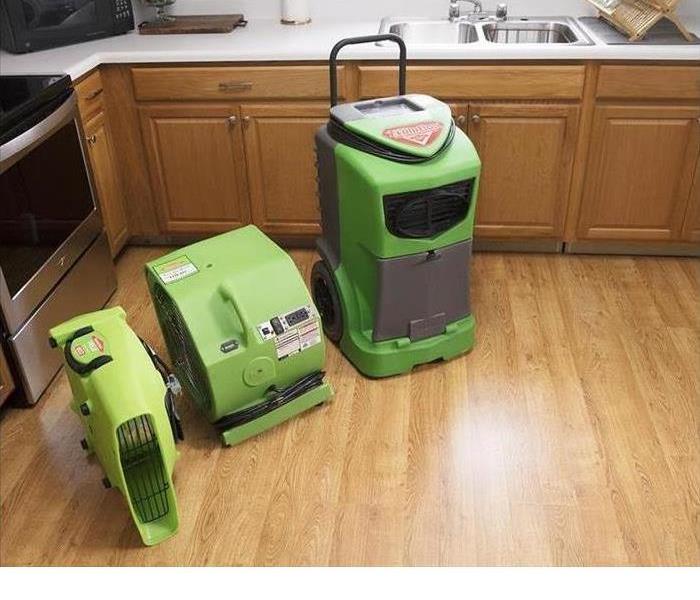 Our team of trained professionals utilize their expertise to make sure your home or business can get back to normal.
Our team of trained professionals utilize their expertise to make sure your home or business can get back to normal.
The restorative drying process is meant for restoration professionals and is designed to ensure that each component and variable is considered to achieve all drying goals.
Principle 1: Provide for the safety and health workers and occupants
Principle 2: Document and inspect the project
Principle 3: Mitigate further damage
Control the spread of contaminants
Control moisture intrusion
Principle 4: Clean and dry affected areas
Our team uses cleaning procedures whenever soils and debris must be removed to expedite the drying process. Restorative drying for professionals is used to control as many factors as possible to complete the most efficient drying process. Once enough water is extracted, evaporation is enhanced by:
- Lowering humidity
- Increasing airflow across wet surfaces
- Controlling temperature of air and surfaces
- Using outside air when possible
- Creating a drying chamber
Principle 5: Complete the restoration and repairs
Best Helpful Hints to Get You Through the Winter and Storms
3/8/2021 (Permalink)
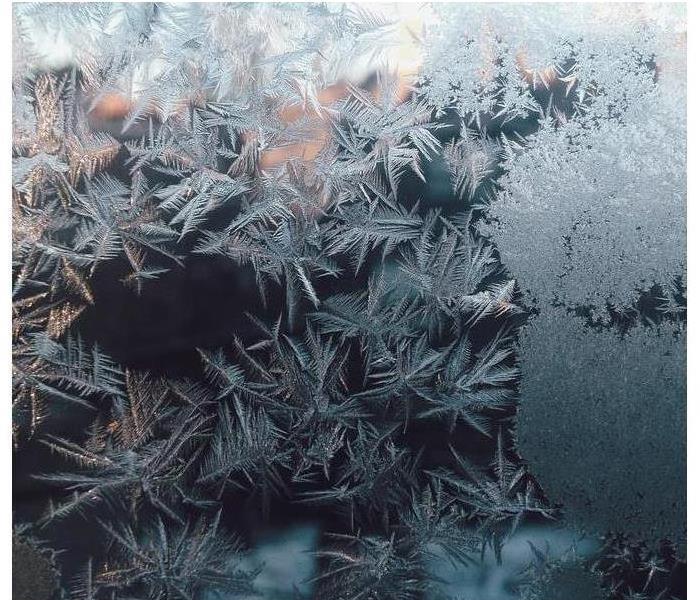 We know winter storms on on their way, so you can call on us when things get out of hand and the cold affects your home or business.
We know winter storms on on their way, so you can call on us when things get out of hand and the cold affects your home or business.
- Ceiling fans are not just for summer: flip the switch to reverse the spin of the fan and turn on the lowest speed to blow warm air down from ceiling.
- Use energy from the Sun: During the day, open drapes and blinds to allow sunlight to help warm the house, land then close at night to hold in heat.
- Dress in Layers: Pack an extra pair of warm socks, blankets, wool sweaters and long-johns or coveralls in your car to keep warm.
- Keep a bag of clay kitty litter in car: If your car gets stuck in deep snow or slick ice, sprinkle kitty litter (non-clumping) at the base of your tires to add some traction to get moving again. Extra weigh in trunk will create added pressure on your tires, ensuring greater contact between your tread and the ground.
- Don’t smoke or drink coffee before shoveling: Caffeine and nicotine are stimulants and can add extra stress to the heart.
- Learn to walk like a penguin: To walk safely on ice, walk like a penguin. Point your feet out, land hold your arms out slightly to your side. Shuffle, land take short steps.
- Easy deicer: The night before freezing temperatures, rub half a potato over your car’s windshield. The sugar from the potato creates a barrier over the window and prevents ice from forming, when you come out in the morning you will not have to scrape! Simply rinse and wipe with your wipers when you get on the road.
- Gas Up: During cold weather months, it is good practice to keep at least a half tank of gas in your vehicle at all times. Not only does it prevent you from being stranded, but it prevents any water in the tank from freezing, which can damage the fuel pump.
- Frozen locks: Squirt a little hand sanitizer on them. The isopropyl alcohol that kills germs also lowers the freezing point of water, and can melt the ice inside the lock within seconds.
- Grab a roll of duct tape and keep it in car: Not only does it fix everything, but you can use it as a fire starter – duct tape is very flammable and is a great tool to get a fire going in an emergency. Don’t forget to have a lighter or matches in your emergency kit.
- Candles: will keep you warm in your car if you are stranded in car. Also, don’t forget to have a lighter or matches.
- No more icy walkways: Sprinkle leftover coffee grounds on your freshly shoveled walk or driveway to help melt the ice – it’s a natural and environmentally friendly way to add more traction underfoot. Remember to wipe feet when going inside.
- Dry wet shoes: by stuffing them with dry newspaper to absorb the moisture quicker.
- Shoveling Snow: Spay shovel with non-cook cooking spray, snow will slide off easier.
- Winter Survival Kit to keep in vehicle: Flashlight, batteries, snacks, water, ice scraper, first aid kit, candle and lighter, phone charger, warm outer clothing and travel shovel.
Smoke Webs
3/8/2021 (Permalink)
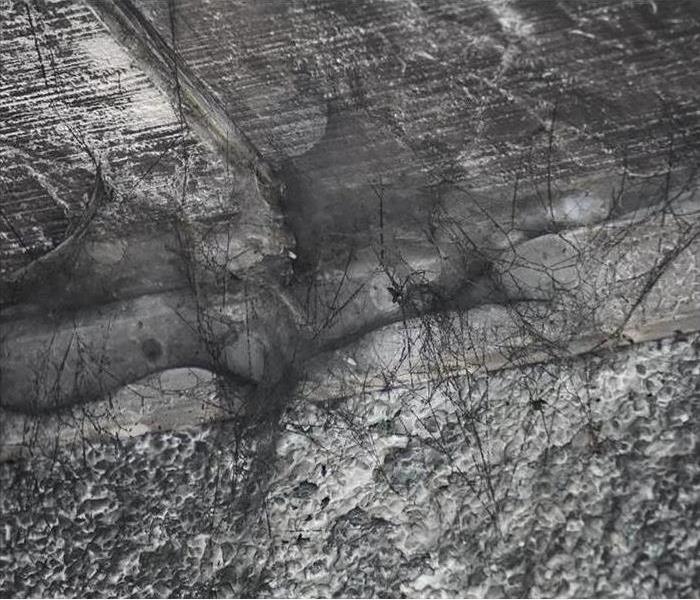 Smoke webs appeared in this apartment complex after a fire caught in the lower level. The fire damage caused smoke and soot damage in the complex.
Smoke webs appeared in this apartment complex after a fire caught in the lower level. The fire damage caused smoke and soot damage in the complex.
In the case of a fire, there can be a situation called smoke webbing. Ionization refers to particles of smoke with opposite charges attracting to each other. The formations of these smoke chains are called "smoke webs" as stated previously. These smoke webs look similar cobwebs. They are usually found at room corners and other parts of the home. The presence of smoke webs indicates combustion of synthetic materials, not spiders or cobwebs as some believe. In every fire, some surfaces can be become deeply embedded with soot and smoke odors. Ionization is one of the factors that influences smoke behavior. And understanding these factors help our team of professionals remove any damage appropriately. If you experience a fire in your home or business, you can call on our team of professionals to properly take care of your fire damage, smoke, and soot.
The Power of Dehumidifiers
3/8/2021 (Permalink)
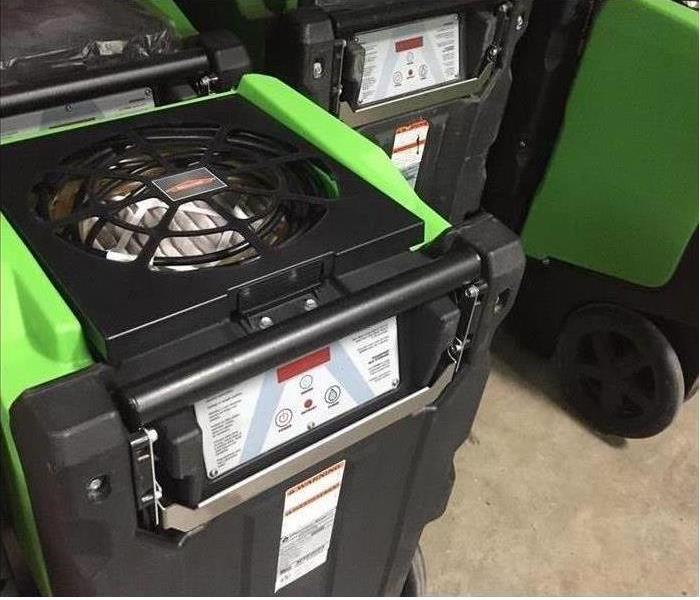 Our team member make sure to come prepared with all the necessary equipment to get the job done in a timely manner.
Our team member make sure to come prepared with all the necessary equipment to get the job done in a timely manner.
We use dehumidifiers as one piece of equipment during our balanced drying system we utilize when we are cleaning up after a water loss. Dehumidification helps to minimize secondary damages. Dehumidifiers used alone are not the only piece of equipment we use. These units are used to capture evaporated moisture in the air. Our team members work to get the moisture out of the material, and they then use air movers and energy to get the water to evaporate. Once evaporated, the vapor can be removed from the air with a dehumidifier. "Dehumidifiers are a sealed refrigeration system with defrost mechanism, fan, and water collection system. The dehumidifier removes energy from the incoming air, then returns this energy as sensible heat to the exiting air. During this energy removal process, water vapor condenses on the evaporator (cool) coil and is collected." - Disaster Academy Training Manual
It's Candle Fire Season!
12/7/2020 (Permalink)
Be Cautious When Using Candles
Yes, that soft light and aromatic fragrances that fill the room from a lit candle can be an easy way to create the atmosphere that you want in your home. However, candles can also become a safety hazard if they are not used properly. Candle fires are common, but the following tips can help you avoid them.
1. Don’t Leave Burning Candles Unattended:
It may seem like an annoyance to extinguish a candle every time you leave the room. However, leaving it burning could result in a candle fire if something gets too close to the flame or if it burns too low. It is best to blow out candles before going to bed at night, even if the candle is in the same room you sleep in..
2. Keep Them Away From Flammable Items:
When you are using a candle, you should be sure to have the area free of flammable objects. This can include papers as well as fabrics such as curtains and bedding. These types of items should be at least a foot away from any candles that are in use. Flammable liquids should be kept even further away.
3. Keep Them Out of Reach of Pets and Children:
Both children and pets often come with an excess of energy and curiosity. For this reason, it can be easy for them to inadvertently start a candle fire. Keep burning candles in an area that are not within reach of a child or pet, especially unsupervised!
4. Use an Alternative:
Perhaps the easiest way to prevent a is simply not to use candles at all. There are a variety of other ways that you can achieve a more relaxing home environment. If you are only interested in adding a nice scent to your home, a wax warmer is a great option. One great option is a diffuser. Diffusers are a great alternative to candles and make you house smell fantastic!
While these tips can help you prevent an emergency, accidents can still occur. Whether it is small or large, fires often require smoke cleanup and some repairs. If this happens, a fire damage restoration company like SERVPRO can help return your home to its preloss condition making it "Like it never even happened."
What is Ozone?
12/7/2020 (Permalink)
If you have ever had a fire on your property and had SERVPRO come out to restore, you will know what an ozone generator is. For those who have not, an ozone generator is a machine that charges the air around it creating O3 out of the O2 molecules we breathe.
What We Use Ozone For
The primary function that we use an ozone generator for is the eliminate odors, especially odors caused by fires. We can use this technique of odor removal in many different cases such as, clothing, furniture, and entire rooms no matter the size. While the odor removal works great, there is a downside to using ozone in excess.
Precautions to Ozone
As stated earlier, ozone is different from the air we breathe. This reaction makes O3 poisonous if it is ingested in excess. This is why we close off the area that is being deodorized during the process. You can trust that we take every precaution necessary to keep our customers and employees safe.
Tree Safety
12/7/2020 (Permalink)
The Christmas season is in full swing. During this time each year, the traditional Christmas tree fills the family room surrounded by presents. BE CAREFUL - Christmas tree fires are infrequent, but they can happen. Listed below are a few good measures that will help ensure your home’s safety:
• Make sure you pick a healthy tree; trees with brown needles indicate dryness.
• Make sure your tree is placed in a sturdy stand to prevent it from falling over.
• Make sure your stand has an adequate basin for water.
• Make sure to check and water your tree daily.
• Check your lights to make sure they are fire resistant and supported by a national testing organization.
• Keep your trees a safe distance from any heat source.
• Make sure that the lights and any extension cords used are in good working condition; look for and replace damaged wires.
• Check all the bulbs to make sure they are working properly.
• Make sure you have adequate smoke alarms in the area and they are working properly.
The SERVPRO of Kearney & North Platte team wants to ensure that everyone has a safe and joyous season. In the unlikely event that a fire were to occur, know that the SERVPRO team has your back!
Where is your sprinkler shut off?
11/6/2020 (Permalink)
Sprinkler systems are commonly installed in commercial and industrial buildings. They save life and structure when a fire occurs. They do cause water damage though when putting out the fire or when the system malfunctions. This is when SERVPRO is Here to Help. We come in and dry the structure when a system malfunctions. Fire sprinklers are activated when the mercury liquid-filled bulb bursts between 135 and 165 degrees. It is thought by many that they are triggered by smoke. They are actually activated by heat. Failures occur with sprinkler heads commonly when the line freezes from cold weather or the head gets hit or pulled on by something. We are here to help when you need it most and want to help prevent issues before they arise. It is always a good idea to know where your sprinkler line shut off valves are located in case you have a malfunctioning system and know who services these systems for your facility.
SERVPRO of Kearney & North Platte specializes in the cleanup and restoration of residential and commercial property after a fire, smoke or water damage event. We can handle any size disaster!
Call us at (308)535-1115
Tips for disinfecting your office.
11/6/2020 (Permalink)
Keeping a clean office environment should be a priority for your company. This will prevent the spread of germs and keep people healthier year-round.
Here are four tips for disinfecting your office:
1.) Wipe surfaces in one direction.
If you wipe a surface one direction and then go back the opposite direction, you are going to spread the germs right back on the surface. A swift wipe in one direction will be most effective in removing germs from a surface.
2.) Make sure you're using the right chemicals.
Make sure you are using the right chemicals for disinfecting. Each cleaning product should be labeled with its intended purpose.
3.) Make sure you get to all of the high-tough areas.
High-touch areas should be at the top of your list for disinfecting. This includes things such as chairs, stair railings, telephones, restroom surfaces and coffee pot handles/dispensers.
4.) Make handwashing a priority in your business.
Stressing the importance of handwashing in your office will go a long ways in preventing the unnecessary spread of germs.
SERVPRO of Kearney & North Platte specializes in the cleanup and restoration of residential and commercial property after a fire, smoke or water damage event. We can handle any size disaster!
Call us at 308.535.1115
What to do and what not to do after a fire.
11/6/2020 (Permalink)
What To Do After A Fire
- Limit movement in the home to prevent soot particles from being embedded into upholstery and carpets.
- Keep hands clean so as not to further soil upholstery, walls, and woodwork.
- Place clean towels or old linens on rugs, upholstery, and carpet traffic areas.
- If electricity is off, empty freezer and refrigerator and prop doors open.
- Clean and protect chrome with light coating of petroleum jelly or oil.
- Wash houseplants on both sides of leaves.
- Change the HVAC filter.
- Tape double layers of cheesecloth over air registers.
What NOT To Do After A Fire
- Don't attempt to wash any walls or painted surfaces or shampoo carpet or upholstery without contacting your SERVPRO Franchise Professional.
- Don't attempt to clean any electrical appliances that may have been close to fire, heat or water without consulting an authorized repair service.
- Don't use any canned or packaged food or beverages that may have been stored near the fire, heat or water.
- Don't turn on ceiling fixtures if ceiling is wet. The wiring may be damaged.
- Don't send garments to an ordinary dry cleaner. Improper cleaning may set a smoke odor.
SERVPRO of Kearney & North Platte specializes in the cleanup and restoration of residential and commercial property after a fire, smoke or water damage event. We can handle any size disaster!
Call us at 308.535.1115
Ozone Deodorizes without Chemicals
11/6/2020 (Permalink)
Activated oxygen machines, otherwise known as ozone machines, work in your home to clean the air of odor. One of the most common uses is for the decimation of smoke odor. These machines work by breaking down the oxygen we breath (O2), and converting it into ozone (O3).
These machines have a wide range of uses and be used in one room of a house or the entire floor of a building. Here at SERVPRO of Kearney & North Platte, we use them quite often when there has been a fire. The activated oxygen machine allows us to clean a room that smells of smoke without using any chemicals. These little machines are not limited to smoke odor cleaning! They can also be used for pet and food odors!
If you have any odors in your home, call SERVPRO of Kearney & North Platte to assess the situation. We have the knowledge, tools and track record to effectively remove odors in your home or business.
Call us today at 308.535.1115
Frozen Pipes: A Winter Water Damage Emergency
11/6/2020 (Permalink)
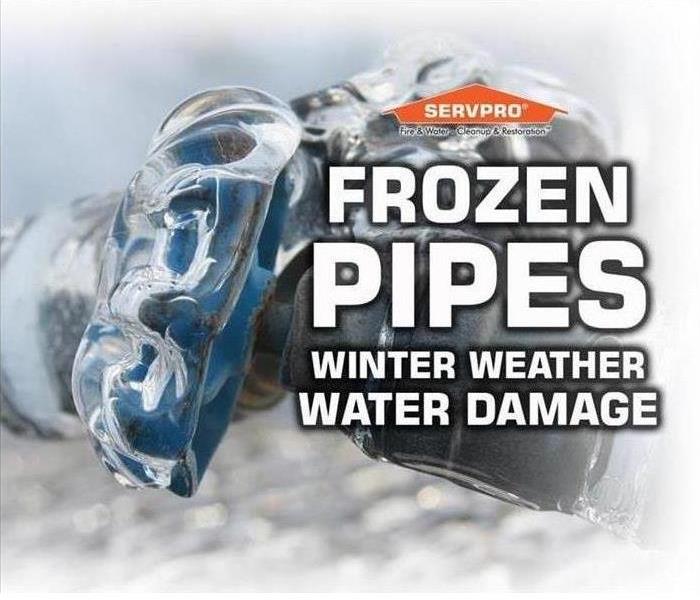 Low Temperatures can freeze pipes, make sure you are keeping an eye on your home during winter.
Low Temperatures can freeze pipes, make sure you are keeping an eye on your home during winter.
We can’t control the weather frigid winter temperatures are here in the Midwest, the lower temperatures cause a new set of seasonal Nebraska property disasters including frozen pipes, ice dams and other frozen water damage concerns.
Every winter our SERVPRO of Kearney & North Platte professionals help countless homes with the restoration, cleanup and repair of their property following a frozen water property disaster.
Why is a Frozen Pipe a Concern?
- When water begins to freeze, it expands. This can cause both plastic and metal pipes to burst, possibly leading to significant water damage to your home or business.
- Since water expands when it freezes, it puts unwanted pressure on pipes.
- As water freezes, the force exerted from the expansion can cause a pipe to burst, regardless of the strength of the material.
- You may not know you have a burst pipe as the water has turned to ice. Once the temperature starts to warm and thawing begins, leaking and flooding can occur.
FROZEN PIPE WATER DAMAGE TREATMENT AND RESTORATION
The key to avoiding costly secondary damage is to handle every water problem as a real threat to your property with proper mitigation. Our SERVPRO of Kearney & North Platte team has the equipment, training and experience to find and dry unseen water before secondary damages occur. We begin removing the standing water from your property with extraction methods, and rapidly dry your structure and contents with dehumidifiers that lower the indoor humidity levels, so your building dries out quickly. When time matters, technology and equipment must be counted on to perform. SERVPRO of Kearney & North Platte professionals will answer your call with rapid action and a full arsenal of drying equipment.
FROZEN PIPE PREVENTION
Short- and Long-term solutions for low temperature plumbing problems include:
- Locate and seal cracks and openings in the walls, attic, basement or crawlspace.
- Weather strip and caulk around crawlspace doors and basement windows.
- Make sure your home is properly insulated. Pay special attention to areas where pipes are located.
- Insulate unprotected pipes and don't leave gaps. Pipe sleeves simplify the process. Keep the pieces tight against each other and seal the slits and joints with duct tape.
- Install storm windows over basement windows or replace the old windows with energy-efficient alternatives.
- Find your main water shutoff so you can turn off the water quickly if needed. Locations vary — look in the crawlspace or basement where the water supply enters the house, inside a water meter box directly outside the house or near the water heater.
- Open cabinet doors under sinks to let warm air flow around the supply lines. Move any cleaners or other chemicals out of the reach of children.
- Keep your thermostat at the daytime setting during the night. If you'll be away for several days during subfreezing weather, keep it set above 55° F.
Autumn Storms
11/6/2020 (Permalink)
Autumn storms are right around the corner. The effect of these storms can be good or bad. As much as we love the sound of thunder, the jolt of lightning going through the sky and the smell of rain, there are bad things that can come along with it. Power outages are often a risk associated with storms. It’s good to know what to do in case you lose power, because you never know how long it could be out. It could be out for a matter of seconds, or for several hours. Here are some tips on what how to be prepared, and what to do during a power outage.
- Keep flashlights available around your house. Avoid using candles when possible.
- Keep the opening of freezers and refrigerators to a minimum. When kept closed, refrigerators can stay cool up to 4hours, and freezers can stay frozen up to 48 hours. If need be, you can put ice in a cooler to keep your food cold.
- Watch out for carbon monoxide poisoning. If you are running a generator, it should be used outside and at least 20 feet away from a window or door. Never use a gas stovetop, oven, camp stove, or charcoal grill to heat your home.
- If it’s cold in your home, add more layers of clothes and blankets. Don’t use the oven or a grill as a heating source. If it becomes too cold, try to make arrangements to go to another location where heat is available.
- Turn off and disconnect any appliances and electronics. The power may surge or spike when it is restored, and that may cause damage to the items.
- If you have a sump pump, keep an eye on it so you don’t end up with a flooded basement.
If a storm occurs, the safety of you and your family is of the utmost importance. Be safe out there!
SERVPRO of Kearney & North Platte specializes in the cleanup and restoration of residential and commercial property after a fire, smoke or water damage event. We can handle any size disaster!
Call us at (308)535-1115
How to Handle a Water Loss
11/6/2020 (Permalink)
Water damage can affect not only the structure of your house but also your belongings. SERVPRO of Kearney & North Platte understands that your home is more than a structure. Your furniture, clothing, keepsakes, and other belongings are important to you. We provide the following services to help restore and protect your belongings while we are restoring your home.
Contents Restoration
SERVPRO of Kearney & North Platte specializes in restoring contents damaged by water. We pretest your contents to determine what items can be restored back to their condition before the water damage. We utilize several methods of cleaning your contents, including:
Dry Cleaning - Used for cleaning light residues or to pre-clean prior to wet cleaning.
Wet Cleaning - An effective cleaning method for removing moderate to heavy residues.
Spray and Wipe - Effective for items that can’t withstand wet cleaning.
Foam Cleaning - Used for upholstery fabrics that might shrink or bleed if wet cleaned.
Abrasive Cleaning - Involves agitation of the surface being cleaned.
Immersion Cleaning - Contents are dipped into a bath of the cleaning product.
Move-Outs/Pack-Outs
If your home requires extensive restoration, SERVPRO of Kearney & North Platte can conduct an organized, efficient move-out of the affected area. A move-out will provide several benefits, including the following:
A quicker remodeling process
Protecting items from potential damage
Protecting contents from further on-site damage
When restoration is completed, we will work with you to coordinate the move-in according to your needs.
On-Site Storage
We have in-house storage where we can keep your belongings safe from further damage, and can provide cleaning and restoration services for your belongings. We have a warehouse dedicated to storage where we can keep your items safe and secure.
SERVPRO of Kearney & North Platte specializes in the cleanup and restoration of residential and commercial property after a fire, smoke or water damage event. We can handle any size disaster!
Call us at (308)535-1115
Winter Water
11/6/2020 (Permalink)
Winter can be freezing and snowy, more often than not it’s just rainy. But that does not mean that winter weather can’t still take a toll on your home and property. We at SERVPRO of Kearney & North Platte want to make sure you know the correct steps to take to prevent damages to your home and more importantly disruptions to your life. Ensure gutters are clean & secure, leaves & debris that accumulate damage gutters and can lead to roof problems & water damage. If winter and cold weather take their toll on your home, make sure to call the team with the knowledge and experience to make it “Like it never even happened.”
SERVPRO of Kearney & North Platte specializes in the cleanup and restoration of residential and commercial property after a fire, smoke or water damage event. We can handle any size disaster!
Call us at (308)535-1115
With Colder Weather Comes Fire Risk
11/6/2020 (Permalink)
Seasonal traditions like Thanksgiving and Christmas require adjustments to our daily routines as the thermometer drops in the region. With these changes come unwanted risks including fire hazards from additional holiday lights, candles and cooking. Below, we list some preventative measures you can take now in order to prepare for the colder seasons.
- Change the batteries in your smoke alarms and carbon monoxide detectors. This process should be completed on an annual basis, preferably at Daylight Savings Time or the beginning of a new season to ensure your home and business is safe and prepared for potential emergencies.
- Check your heaters and HVAC systems for signs of failure and damage. Heating systems pose a significant threat of fire damage during the fall and winter months, so preparation and HVAC system inspections are critical in order to eliminate the risk of fire or lack of heat in your home. Any space heaters should be also be placed away from items that pose a risk such as clothing.
- Fireplaces should be inspected annually to ensure they do not pose a risk, and combustible materials should be kept a safe distance away.
- Clear your roof and gutters of debris that can collect and pose a risk if ignited.
- Do not leave a fire of any kind unattended.
As colder weather ushers in to the metro-east region of Illinois, so does the risk of fires in your home or business. SERVPRO of Kearney & North Platte wants to remind you about safe practices and safety precautions this fall and winter. Along with many other preventative measures you can take, these steps are critical in helping to keep you, your family safe.
If your home or business does experience a fire damage event of any size, our team is here for immediate assistance. Our fire restoration professionals can handle the entire restoration and reconstruction process for you in order to help ease the stress that often comes with these types of disasters. For more information, give us a call at (308) 535-1115.
Why SERVPRO
11/6/2020 (Permalink)
Since we are locally owned and operated, we are able to respond quicker with the right resources, which is extremely important in a disaster event. A fast response lessens the damage, limits further damage, and reduces the restoration cost.
Resources to Handle Floods and Storms
When storms hit, we can scale our resources to handle a large storm or flooding disaster. We can access equipment and personnel from a network of 1,650 Franchises across the country and elite Disaster Recovery Teams that are strategically located throughout the United States.
SERVPRO of Kearney & North Platte specializes in the cleanup and restoration of residential and commercial property after a fire, smoke or water damage event. We can handle any size disaster!
Call us at 308-535-1115
Fire Drills are a Good practice to get into
10/30/2020 (Permalink)
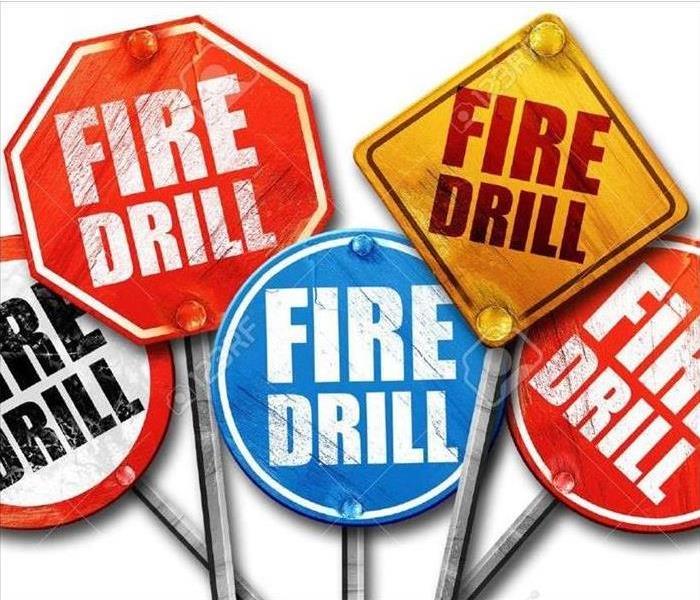 Fire Drills
Fire Drills
Fire drills are not just for schools, they should be practiced by businesses and families alike. It is crucial to the safety of all that everyone knows more than one way to exit your building or home. Important things to cover are a designated meeting spot (a safe distance from the structure where a head count can be taken to inform first responders of anyone left in the building), and what to do should you not be able to have an escape route. Here at SERVPRO we suggest that customers regularly perform a “fire drill” so that everyone knows what to do and how to keep themselves and others safe. If disaster should strike your home, we are ready 24/7, 365. Call us at 308.535.1115 to help walk with you through the cleanup and repairs to help you make it “Like it never even happened.”
SERVPRO of Lincoln specializes in the cleanup and restoration of residential and commercial property after a fire, smoke or water damage event. We can handle any size disaster!
Call us at 308.535.1115
Why the IICRC is Important
10/28/2020 (Permalink)
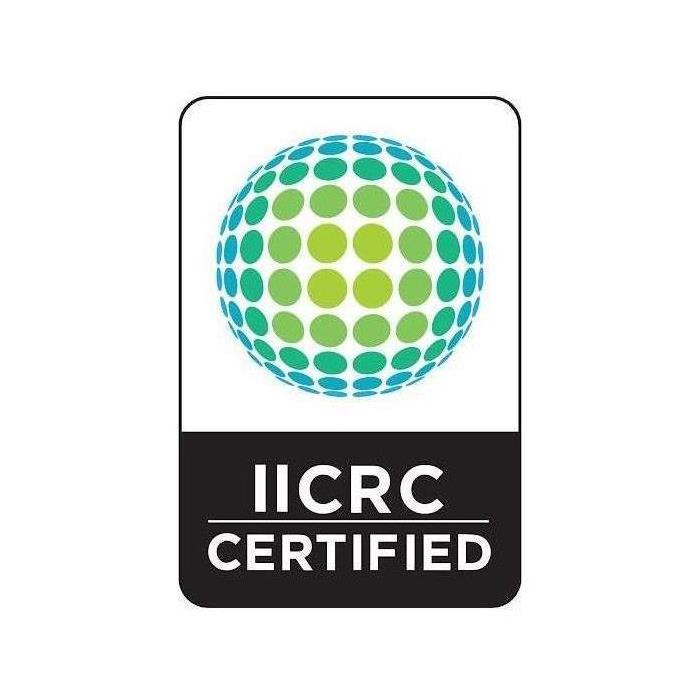 IICRC
IICRC
What is the IICRC? The Institute of Inspection Cleaning and Restoration Certification is a nonprofit organization for the cleaning and restoration industry. Our SERVPRO team members study IICRC best practices guidelines for fire damage, water damage restoration, and mold remediation. It is a certification and standard-setting organization. IICRC standards are developed to provide the highest quality concepts, terminology, and procedures recognized in the cleaning and restoration industry. There are many certifications that our team members earn and our SERVPRO team of franchise professionals make sure to keep up with the certifications as technology and material changes. Our team members take the certifications to be prepared for any situation and to properly address the problem and apply efficient and thorough mitigation for your business or property.
SERVPRO of Kearney & North Platte specializes in the cleanup and restoration of residential and commercial property after a fire, smoke or water damage event. We can handle any size disaster!
Call us at 308.535.1115
We Are Here For You When Fire Damage Strikes
10/28/2020 (Permalink)
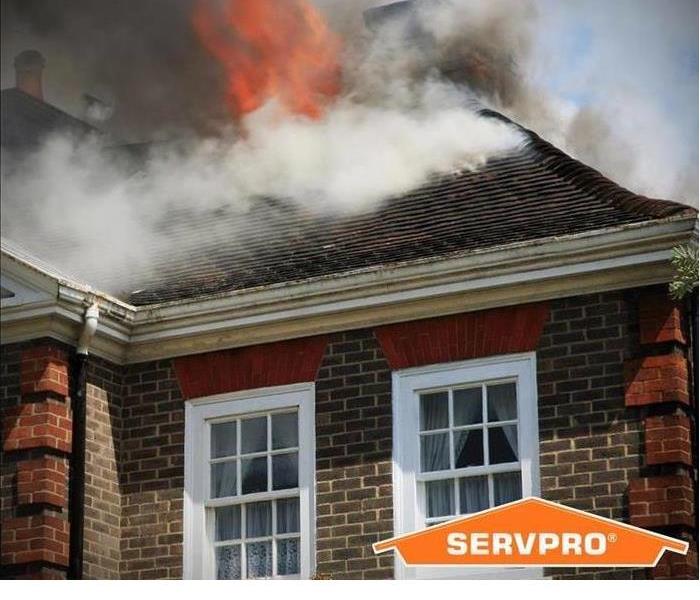 House Fire
House Fire
The damage caused by a fire doesn’t end when the flames have been extinguished. When dealing with fire damage, homeowners often see their possessions that they spent their lives working for along with the roof over their heads destroyed, leaving them searching for a safe place to stay while they figure out what's next. Meanwhile, businesses can find themselves in financial struggles and unable to deliver their goods and services leaving them exposed to potential loss of clients, marketing share and potentially not re-opening. Rapid fire damage restoration can hold the key to limiting the emotional and financial struggles caused by a fire. SERVPRO understands this and knows how important it is to get your lives back to normal and businesses back open.
EVERY 65 SECONDS!
According to the latest numbers from the National Fire Protection Association, a structure fire is reported every 65 seconds. When a fire alarm sounds, emergency responders and fire departments answer the call for help with rapid response and deployment to the scene of the fire. When the fire is out and the smoke clears, SERVPRO team members respond, ready to help with the same rapid response and quick deployment to your damage home or business – 24-hours a day, 7 days a week, 365 days a year.
WE ARE HERE FOR YOU ALWAYS
At SERVPRO, we never take a day off because we know fires happen anytime, all the time and we are to serve you!
Call us today 308.535.1115.
Why Would You Want Commercial Insurance?
10/28/2020 (Permalink)
 Commercial Insurance
Commercial Insurance
If you own or run a business in it’s extremely important to have a commercial insurance policy to protect your assets from a potential catastrophic fire or other catastrophe. This type of insurance may prove invaluable in many ways after an emergency. Here are a few reasons you may want to consider having commercial insurance.
1. Commercial Insurance May Cover Restoration Costs
In most cases, a fire or water restoration process at your business can include a number of costs for both the structural repairs, fire damage cleanup, the contents cleaning, document restoration, and any additional services that might be restored. That can be a lot of different services you may not have initially realized will be necessary to restore your business to it's original condition before the damage occurred. Commercial insurance takes these types of repairs into account and may include them under your policy.
2. Commercial Insurance May Recommend a Restoration Service Provider like SERVPRO
Another important aspect of commercial insurance is the fact that in many cases the carrier may have a preferred cleanup and restoration service provider they work with or contract. These providers are usually industry certified restoration professionals who may have a number of tools that allow them to communicate and work with your insurance provider. This means you won’t have to waste time looking for a trusted company, as your insurance agent or adjuster may already have their number on file.
3. Commercial Insurance May Cover Secondary Damages and Business Interruption
If your policy includes secondary damage coverage you may find that the cost of some unexpected repairs may be covered. Secondary damages are damages that occur as a result of the initial problem. For example, the need for a smoke cleanup, or water damage repairs could occur along with or after an initial fire damage.
Maintaining a commercial insurance policy for your Kearney & North Platte business can be a good idea for a number of reasons. A commercial policy may be able to cover a number of costs associated with cleanup and repairs, including the services from a restoration provider. Your insurance provider may even recommend a specific team for you to work with like SERVPRO. Additionally, depending on your policy, secondary damages may also be covered which can help with unexpected damages, not to mention monies for lost revenue due to business interruption.
Kitchen Fire
10/28/2020 (Permalink)
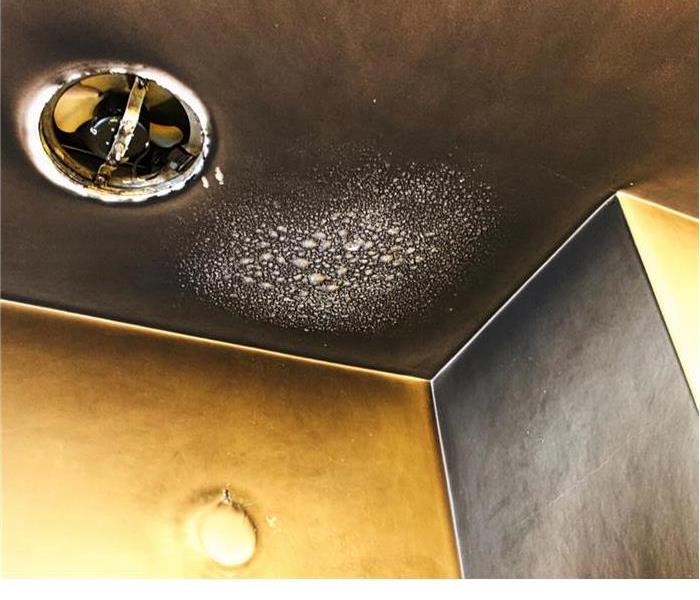 Kitchen Fire
Kitchen Fire
Cooking is something that most every person does on a daily basis. It is an activity that is so normal, that it can be easily forgotten how dangerous it can be. The temperatures required to cook are easily hot enough to start a fire if left unattended.
According to the NFPA, in 2018 the “United States fire departments responded to an estimated average of 172,100 home structure fires per year started by cooking activities in 2012-2016, or an average of 471 home cooking fires per day. These fires caused an average of 530 civilian deaths, 5,270 reported civilian fire injuries, and $1.1 billion in direct property damage per year.”
As you can see, fire damages not only happen often, they are expensive as well. This is because when a fire occurs it damages much more than just the structure of your home or business. The heat from the fire can change the chemical makeup of food items, textiles, furniture, and much more.
Another variable to consider is the amount of soot that the fire spreads across your home. Even a small fire in a small corner of your home or business can spread soot over the entire property. The soot gets into the duct systems and is then cycled through the property by the HVAC system. This is why you should trust our highly trained professionals come in and clean the property properly. At SERVPRO, we have a restore first mindset and will do our best to restore any items affected by fire.
What should be disposed of after a kitchen fire:
- Nonperishable food items - even though these food items are sealed, the heat from the fire can activate bacteria in the cans or jars causing the food to go bad.
- Room temperature perishable food items - a sealed refrigerator can keep food safe to eat for up to two hours without power as long as it is left shut. However, if when the refrigerator is opened, even within that two-hour zone, and a strange odor is present, it would be a good idea to dispose of the items inside.
- Burnt clothing - all clothing burned by the fire should be disposed of even if it is just barely burned.
- Cosmetics and medications - carefully sort through and examine cosmetics and medicine. If there are any signs that the container has been compromised, dispose the item.
A reliable rule of thumb after a kitchen fire is to get rid of items stored in cardboard, thin plastic bags, or cloth.
SERVPRO of Kearney & North Platte is a team you can count on to be Faster to Any Size Disaster. Call (308) 535-1115 today for a fast disaster cleanup service from an experienced team.
Fire Safety During Thanksgiving
10/28/2020 (Permalink)
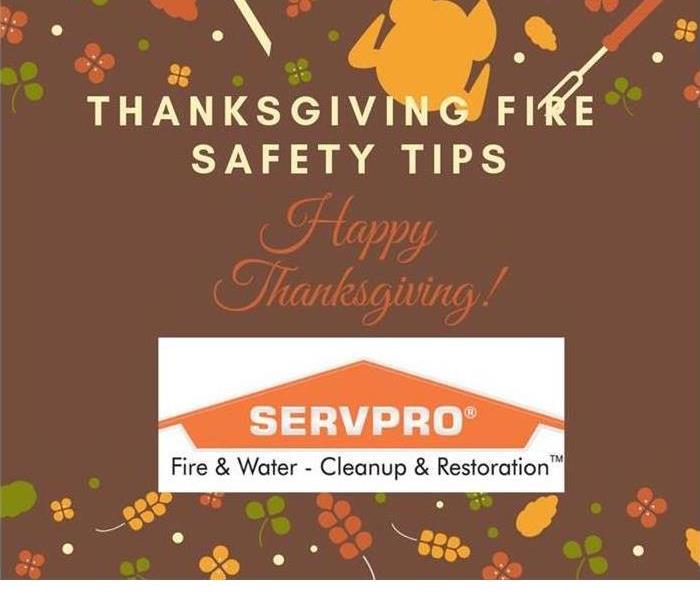 Thanksgiving is the busiest holiday of the year, make sure you stay safe during this busy time!
Thanksgiving is the busiest holiday of the year, make sure you stay safe during this busy time!
Did you know that Thanksgiving is the busiest day of the year for fire departments when it comes to home fires involving cooking equipment? With more home cooks cooking larger meals than they are probably used to, the number of home fires involving cooking equipment spikes to nearly 4 times the daily average on Thanksgiving! Whether you plan to be in charge of the kitchen or are just helping out, be sure to follow these important safety tips when preparing this year's Thanksgiving feast!
- Start your Thanksgiving with a clean stove and oven! The weekend before Thanksgiving, remove any food or grease buildup from burners, stovetops, and the oven.
- Always stay in the kitchen when you are cooking on the stovetop. While items in the oven may not require as attentive an eye, food on the stovetop should have constant monitoring in case of spillage or splatter.
- Stay in the home while cooking the turkey. You don't need to set up camp and keep a constant eye on the turkey once it's in the oven, but you should stay inside and check on it frequently. The last thing you want is a burnt turkey that sets your kitchen on fire!
- Keep a flame-resistant oven mitt, potholder, or lid near your cooking space so that you can smother any flames before they get out of control.
- Should an oven fire occur, turn off the heat and keep the door closed. This should allow the fire to burn out on its own. Once the fire has gone out, open your windows before carefully opening the oven door to release the smoke.
- Make sure your home has working smoke alarms and that your family knows the fire escape route in the event of a fire. Remember to always plan TWO WAYS OUT of every room.
- Avoid using turkey fryers, but if you must, make sure to follow the fryer's instructions. Also be sure to completely thaw the turkey before frying and always fry outside at a safe distance from the home.
Stay safe this holiday season! Should your home experience any fire damage, be sure to call SERVPRO of Kearney & North Platte to make that fire "Like it never even happened."
Deodorizing After A Fire Damage
10/28/2020 (Permalink)
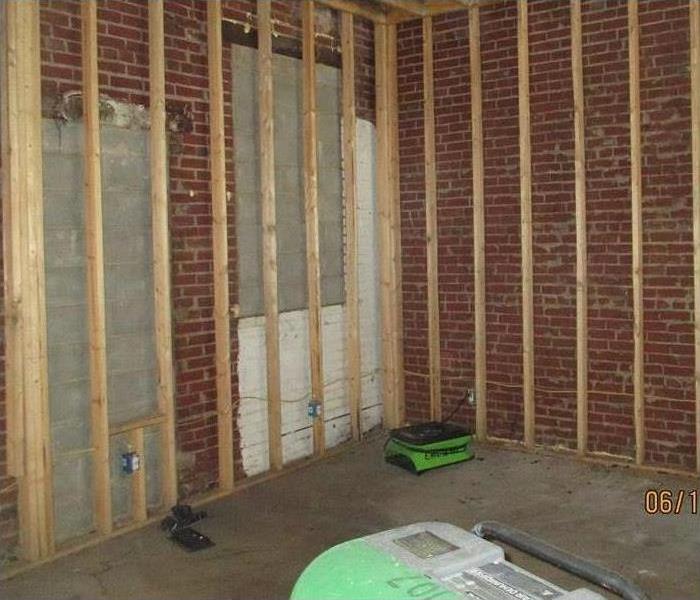 Ozone Machine
Ozone Machine
Things You Should Know
One of the biggest problem after an incidence of fire is the lingering, foul, burnt odor. If the odor is not remedied professionally, it can stay on your property for a long time making it almost impossible to stay there.
Thankfully, professionals can help you get rid of this odor after fire damage to your Lenexa home. The odor after an incidence of fire is a mix of chemical and natural odors due to the burning of wood, plastic, and other building material. Here at SERVPRO, we employ a multi-step process to eliminate odor and get your home smelling like home again- removing, and cleaning. Let's take a closer look at every step.
Removing
One of the first things that SERVPRO technicians do while tackling an odor problem after a fire is removing the source of the odor. The source of odor after a fire damage can be burnt wood or other building materials. Our IICRC certified technicians dispose of the source in a safely and efficiently.
Cleaning
The second step during the deodorizing process is cleaning. Smoke and soot residues can deposit on and even penetrate the various surfaces such as walls and ceilings. SERVPRO technicians clean different surfaces depending on the type of the surface and residue deposited on it.
Sealing
Sealing is not required in most cases, but if the damage is extensive and the removal of the source is too expensive or impractical, it is the best option. Painting walls to seal in the odors is one such case.
We are here to help you in your hour of need. Call SERVPRO of Kearney & North Platte today!
Prepare your home or business for winter weather
10/28/2020 (Permalink)
 Prepare your home for winter weather
Prepare your home for winter weather
Winter weather brings freezing temperatures, and the Tigard/Tualatin and surrounding area is anticipating snowy conditions. Ensure your home or business is prepared by reading the tips below.
- Drain water from the swimming pool and water sprinkler supply lines. Do NOT put antifreeze in these lines unless directed; antifreeze is environmentally harmful and is dangerous to humans, pets, wildlife, and landscaping.
- Close inside valves supplying outdoor hose bibs. Open the outside hose bibs to allow water to drain. Keep the outside valve open so that any water remaining in the pipe can expand without causing the pipe to break.
- Add insulation to attics, basements and crawl spaces, if needed. Insulation will maintain higher temperatures in these areas.
- Ensure that areas, where water supply lines are located, are insulated enough. Consider leaving kitchen and bathroom sink cabinet doors open and dripping overnight if you think they risk being frozen.
- Consider installing specific products made to insulate water pipes. Newspapers can provide some degree of insulation and protection to exposed pipes - even ¼” of newspaper can provide significant protection in areas that usually do not have frequent or prolonged temperatures below freezing.
If you will be going away during cold weather, leave the heat on in your home set to a temperature no lower than 55 degrees Fahrenheit. Temporarily suspend the use of lower nighttime thermostat temperatures to lower the risk of frozen pipes.
SERVPRO of Kearney & North Platte specializes in the cleanup and restoration of residential and commercial property after a fire, smoke or water damage event. We can handle any size disaster!
Call SERVPRO of Kearney & North Platte (308) 535-1115.
Have You Checked Your Sump Pump Lately?
10/28/2020 (Permalink)
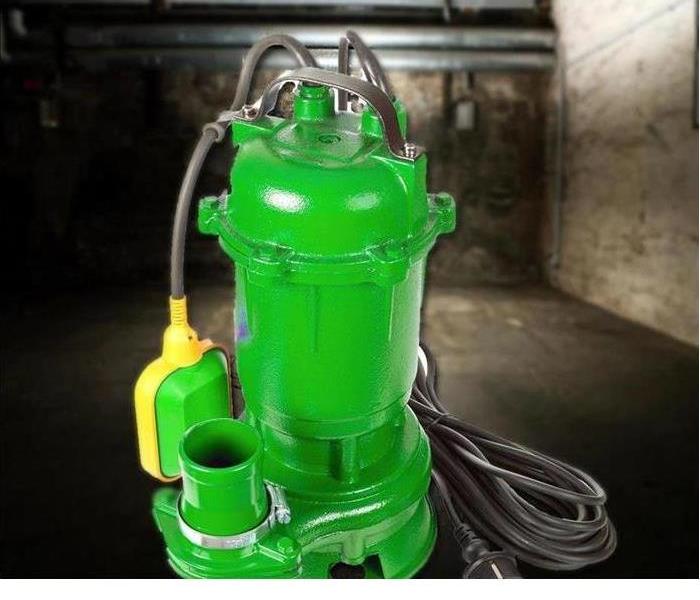 Sump Pump
Sump Pump
A properly functioning sump pump can be the difference between an expensive water damage and a dry basement. There are two types of sump pumps that you may have in your basement: “submersible” pumps are installed under the floor in your basements, while the “pedestal” pump sits above your sump basin. Sump pumps are used to “pump” groundwater away from your home and will evacuate large quantities of water, such as flooding and sewer backups to other areas, such as storm drains. It's important to keep your sump pump in good working order, so it can keep your basement dry all year long. To learn more about sump pump maintenance, check out these common sump pump mistakes people make.
NEGLECT
Simply put, some homeowners never even check on their sump pumps until it's too late. Many homeowners simply ignore routine maintenance and checking their sump pump system on regular intervals. It's possible you may not have a properly functioning sump pump until your basement is several inches under water.
DO IT YOURSELF INSTALL
Have you ever told yourself; "I wish I would have called a professional to do it." If you’ve never installed a sump pump, don’t risk doing it yourself. You'll end up paying a lot more for damages than for the cost of proper installation by a professional installer. Hire a plumbing professional to avoid the risks of faulty installation.
NO BACKUP POWER
During a storm or utility company power outage, your home can lose power, causing your sump pump to shut down. Should you experience flooding in your basement, a sump pump would redirect any incoming water. Keep your sump pump working during a power outage by connecting it to a backup power source, such as a generator or battery backup system.
IGNORING THE DISCHARGE PIPE/FLOAT SWITCH
Check that the drainage pipes are tightly connected and are directed away from your home’s foundation. Also, inspect the pipe for damage and clogs. Seek help at once if you find clogs or damage. Anything that impedes the flow could result in basement flooding due to slow drainage or no drainage at all.
The float switch tells the sump pump motor to stop once the water level goes below the float. Your sump pump needs ample space around the float to both float and sink freely. This should be inspected on a routine basis.
ROUTINE MAINTENANCE
Routine sump pump maintenance goes a long way in guarding against basement flooding. Schedule a thorough inspection with a septic tank maintenance professional or plumber twice a year. For professional water damage restoration or mold removal, contact SERVPRO of Kearney & North Platte.
Wait! Don't Touch That Fan!
10/28/2020 (Permalink)
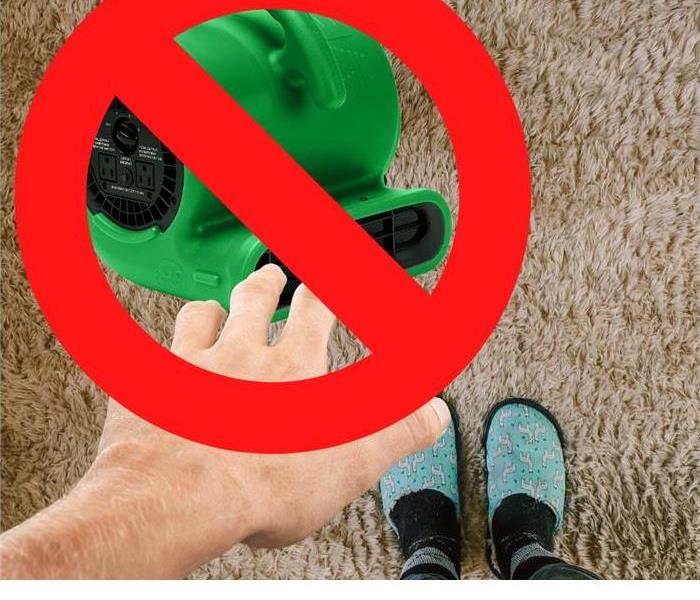 Before touching set equipment, give us a call. We set our equipment with a purpose
Before touching set equipment, give us a call. We set our equipment with a purpose
Let’s set the scene:
SERVPRO of Kearney & North Platte has come to your home after a water damage occurred. Contents have been removed and it is time to start the drying process with to get it back to “Like it never even happened.”
The first thing that will happen is if there is an excess amount of water in the carpet, the technicians will extract that water. After extraction, the flooring will still be damp. This is where we will place our air movers or “fans.”
Did you know that we place the air movers in a specific way that speeds the drying process? The placement of our fans creates the ideal airflow that circulates in dry air from the humidifiers, which evaporates the moisture in the flooring. To the untrained eye, it may not seem that way, but we have a purpose for doing the things the way we do. If you have any questions regarding the process, it is best to direct those questions to the trusted SERVPRO of Kearney & North Platte's team.
If a piece of our equipment stops working while we are not on site, we will need to know as soon as possible so that we can replace the faulty equipment. In this case, also give the lead on your loss from SERVPRO of Kearney & North Platte a call.
Be ready for a Bio-Hazard
10/28/2020 (Permalink)
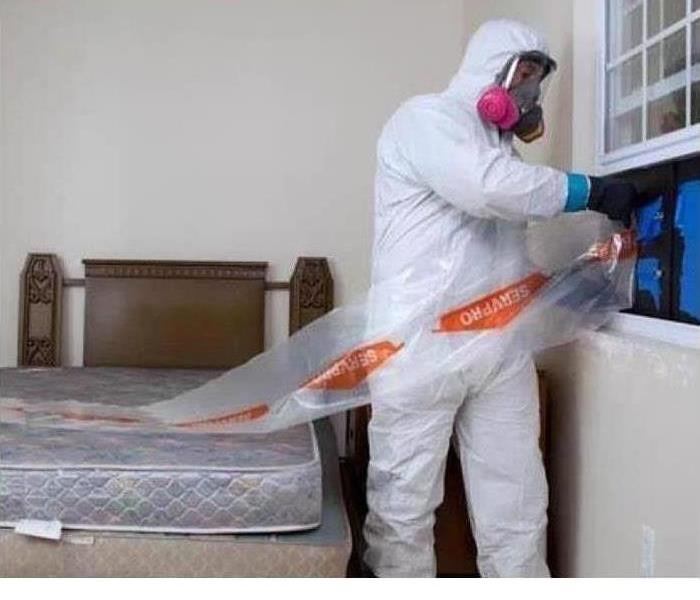 Biohazard Clean up
Biohazard Clean up
Sometimes life takes an unexpected turn and you are faced with situations you never could imagine. We will come out and perform an inspection with you to help determine the plan should a bio-hazard occur at your business. Our trained technicians will create a Ready Plan with you so that all your team members will know what to do and whom to call should a disaster strike.
SERVPRO of Kearney & North Platte specializes in the cleanup and restoration of residential and commercial property after a fire, smoke or water damage event. We can handle any size disaster!
Call SERVPRO of Kearney & North Platte at (308) 535-1115.
Rely on SERVPRO for Safe Biohazard Cleanup
10/24/2020 (Permalink)
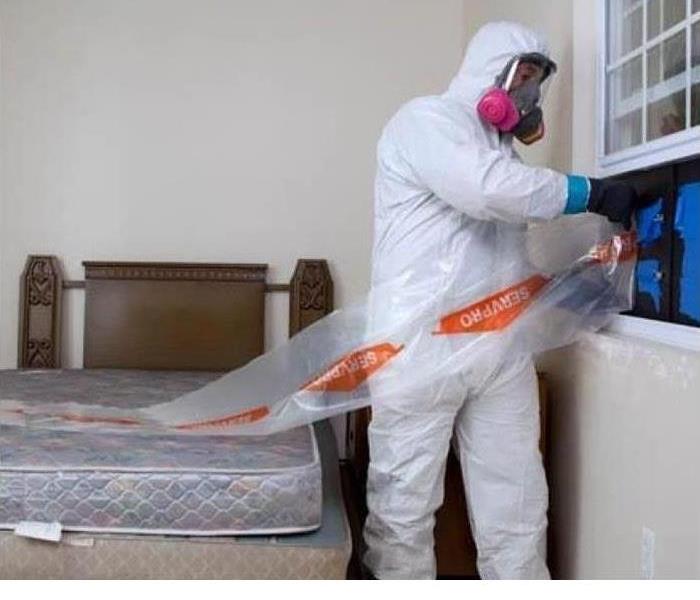 SERVPRO Biohazard Clean up
SERVPRO Biohazard Clean up
Rely on SERVPRO for Safe Biohazard Removal from Your Kearney or North Platte, Nebraska Home or Business
Blood, bodily fluids, and other biohazards can endanger anyone who comes in contact with them. Even trace amounts so small that they cannot be seen with the naked eye can pose serious health risks. When a site in your home or business has been contaminated, how do you make it safe again? Rely on the professionals at SERVPRO of Kearney & North Platte for top-notch biohazard cleanup and restoration services.
Avoiding Health Risks
Is it necessary to seek professional assistance in cleaning up a location impacted by crime, trauma or death? With the risks posed by blood-borne pathogens and dangerous communicable diseases, cleaning a scene contaminated with biohazards like blood is a perilous undertaking for anyone who lacks the proper training and equipment. It is unpleasant to think about, but blood and bodily fluids are prone to splattering so that minute amounts can affect a wide area. The air at these scenes can be hazardous since small particles can become airborne if dried material is disturbed. Anything removed from the scene must also be disposed of properly to avoid spreading the contamination. Besides, you cannot assume the area is safe again just because the visible traces have been removed. If a space contaminated with blood or other biohazards is not appropriately cleaned, sanitized and restored, these unseen hazards can linger, posing a threat to anyone who enters it. Ultimately, the best way to make sure that a place is once again safe is to use a professional organization like SERVPRO that is experienced in biohazard restoration.
Preventing Legal Repercussions
As if the health risks created by biohazards are not dire enough, failure to have a contaminated space properly cleaned can also have serious legal consequences. The responsibility for cleaning up after a crime, trauma or death falls on the Kearney or North Platte property owner, and there are regulations and laws regarding how biohazards are handled that must be followed. These rules are designed to safeguard everyone, and ignorance is not considered an acceptable excuse for disregarding them. Individuals and businesses that do not follow these rules may find themselves facing hefty fines. They might even be held liable if someone else is injured by their actions. Using a professional team that understands what is required to comply with the various rules and regulations governing biohazards in your area can shield you from both health risks and legal issues.
Focusing on Your Safety
At SERVPRO of Kearney & North Platte, we are committed to the well-being of our customers. Offering emergency services 24 hours a day, we will rapidly respond whenever you request our assistance. Our technicians follow the protocols established by the Occupational Safety and Health Administration (OSHA) and the Environmental Protection Agency (EPA), so you can be confident that they have the expertise and training to remove all biohazards and dispose of them properly. We use specialized equipment that allows us to detect the presence of even a minute trace of a biohazard, and we do not stop until your scene is thoroughly sanitized. As biohazard restoration professionals, we can often salvage items that others might have to discard, and we ensure that any material that does need to be removed from your location is disposed of appropriately.
Dealing with a crime, trauma or death is undoubtedly difficult, but you can depend on SERVPRO of Kearney & North Platte for courtesy, empathy, and the quality biohazard cleanup and restoration services that you need. Safety-minded, we are ready to do our part in restoring your space and your peace of mind. If a traumatic event has occurred on your property and you require assistance with the cleanup, contact us now at 308.535.1115.
You Can Weather any Storm
10/19/2020 (Permalink)
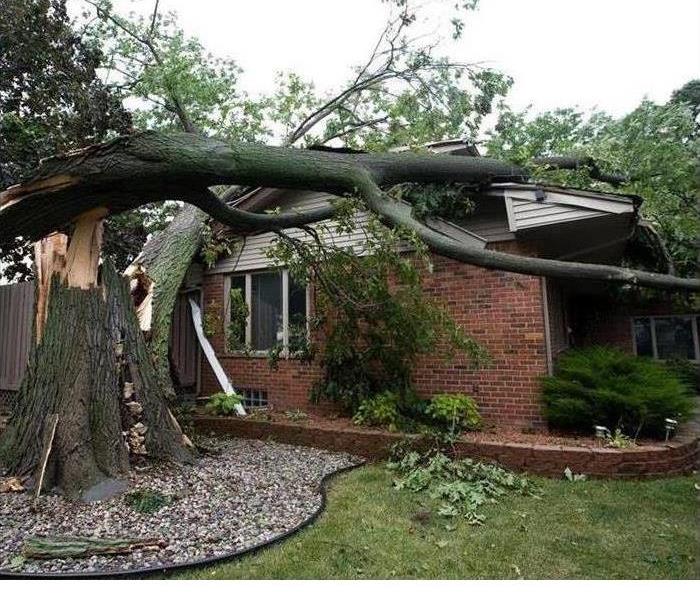 Storm damage
Storm damage
As a business, it is your job to weather any storm that comes your way no matter the type or size. Sometimes physical storms are unexpected and can be quite devastating and detrimental to a business. Here at SERVPRO, our job is to give some peace of mind and help instigate water and fire damage cleanup and restoration. We are capable of traveling anywhere to help get the property back to preloss conditions. Our SERVPRO team of franchise professionals have access to a semi-trailer that is meant to stock up for any disaster that could strike your business. We make our services available 24 hours a day for 365 days a year for whatever could happen. We want to ensure you will be helped during overwhelming and unexpected times. We come ready for whatever disaster occurs. No matter the weather or time of day, we will be there to assist.
SERVPRO of Kearney & North Platte specializes in the cleanup and restoration of residential and commercial property after a fire, smoke or water damage event. We can handle any size disaster!
Call us at 308.535.1115
When you need a board-up call SERVPRO.
10/19/2020 (Permalink)
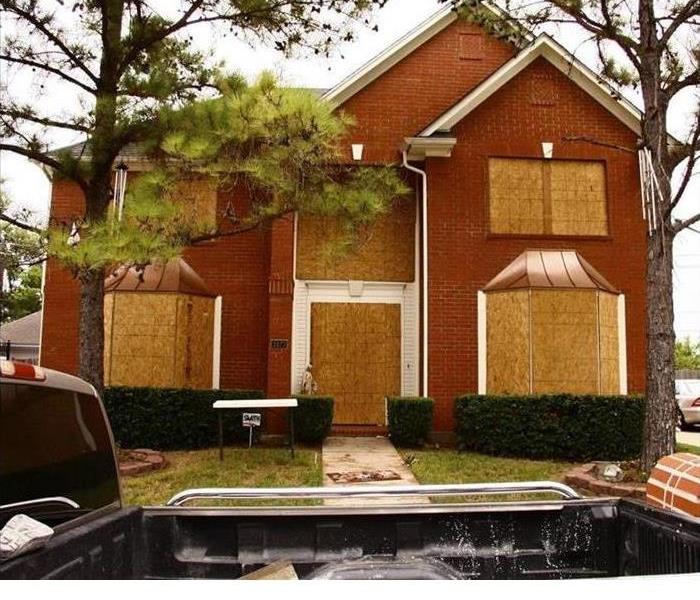 SERVPRO Board up
SERVPRO Board up
Situations such as vandalism and graffiti can be very upsetting and overwhelming for homeowners and businesses. Vandalism and graffiti can range from relatively minor pranks to malicious destruction of property. Often simple acts of vandalism, like breaking a window, can cause significant water and mold damage if not addressed in a timely manner. Here at SERVPRO, we have the capability to help with this property damage. We can do a board-up which is done after a storm, fire, or vandalism incident where the building is exposed to the elements. It is meant to prevent further damage from happening to the facility. It minimizes property loss by securing the building and taking care if restorable/reusable elements. A natural disaster can leave your facility vulnerable to problems such as vandalism, theft, and unwanted entry.
SERVPRO of Kearney & North Platte specializes in the cleanup and restoration of residential and commercial property after a fire, smoke or water damage event. We can handle any size disaster!
Call us at 308.535.1115
Fireplace Safety Tips
10/19/2020 (Permalink)
With the winter season upon us and the temperature starts to drop, we often turn to anything that can keep us warm in our homes. From heating a certain room with our space heaters to cuddling up with your loved ones in front of a warm fire. All of which can be potentially dangerous. Here are some tips to keep you safe while turning up the heat.
Fireplace Safety Tips:
- Before starting a fire, make sure the damper or flue is open. Keeping this open will draw smoke out of the house. Using a flashlight to look up the chimney can check the damper. Never close the damper until the embers have completely stopped burning.
- Use dry or aged wood in your fire. With dried wood, it burns with less smoke and burns more evenly. If you use wet or green wood, this cause more smoke and contributes to soot buildup in the chimney.
- Smaller pieces of wood positioned on a grate burn faster and produce less smoke.
- Make sure to clean out ashes from any previous fires. The levels of ash at the base of the fireplace should be kept to 1 inch or less. A thicker layer restricts the air supply to logs, resulting in more smoke.
- You should get your chimney checked annually by a professional. Even if the chimney is not due for cleaning, it is very important to check for animal nests or any other blockages that could prevent smoke from escaping.
- The area around your fireplace should be clear of anything that is potentially flammable.
- Never leave the fire in your fireplace unattended. Make sure the fire is out completely before going to bed or leaving the house.
- Install both smoke and carbon monoxide detectors. Make sure to test them monthly and change the batteries at least once a year.
- Keep a fire extinguisher on hand.
Peace of mind over the holidays and winter season can be increasingly difficult. Educating your family on these safety measures can eliminate the likelihood of a fire in your home and keep your family safe and sound.
SERVPRO of Kearney & North Platte specializes in the cleanup and restoration of residential and commercial property after a fire, smoke or water damage event. We can handle any size disaster!
Call us at 308.535.1115
Recovering From A Water Damage
10/19/2020 (Permalink)
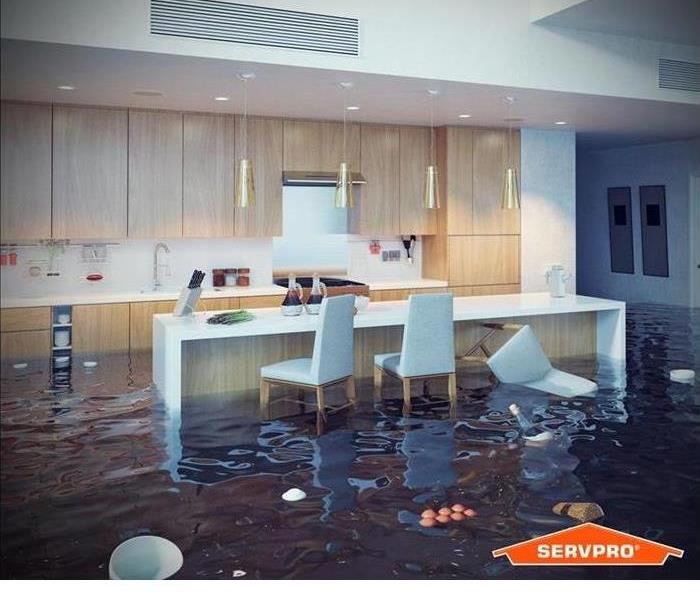 Kitchen Flood
Kitchen Flood
When it comes to water damage in the U.S., almost 40% of homes have incurred losses due to this type of occurrence. Most of these problems are caused by a neglected or damaged roofs, old or faulty plumbing, broken washers and water heaters. Natural disasters such a flood events or hurricanes also ruin homes and businesses with their destructive forces.
During a water damage disaster, many homeowners and businesses feel hopeless, especially if most of the structure is still under water. The situation may appear bleak, but in most cases, there is a great chance of recovering your home or business from water damage quickly. The first step is not to panic. Keep calm and figure out where to begin. This is where an Emergency Plan should be considered before an event like this strikes. Check out https://www.ready.gov/plan. Here are some simple steps to guide you to a successful home recovery after water damage.
We are Cleaning Experts
3/16/2020 (Permalink)
SERVPRO is Here to Help during this time of need
During this unprecedented time caused by the global pandemic of coronavirus, this is a reminder to our customers that we are specialists in cleaning services, and we adhere to the highest cleaning and sanitation standards.
Specialized Training
We are prepared to clean and disinfect your home or business, according to protocols set forth by the Centers for Disease Control and Prevention. We have years of experience in dealing with biological contaminants, and we will go beyond the scope of work that regular janitorial staff performs on a daily basis.
The CDC encourages cleaning of high-touch surfaces such as counters, tabletops, doorknobs, light switches, bathroom fixtures, toilets, phones, keyboards, tablets, and tablets. Other spaces mentioned in the CDC’s guidance for commercial spaces include:
- Kitchen/Food Areas
- Bathrooms
- Schools/Classrooms
- Offices
- Retail Spaces
- Water Fountains
- Shelving/Racks
- Sales Counters
- Carpets and Rugs
- Stair Handrails
- Elevator Cars
- Playground Equipment
- Fitness Equipment
Specialized Products
The CDC recommends usage of a labeled hospital-grade disinfectant with claims against similar pathogens to the coronavirus. Multiple products in the SERVPRO product line carry the EPA-approved emerging pathogens claims. While there is currently no product tested against this particular strain of the coronavirus, we are following all guidelines as provided by the CDC and local authorities.
Call Today for a Proactive Cleaning
SERVPRO of Kearney & North Platte specializes in the cleanup and restoration of residential and commercial property after a fire, smoke or water damage event; as well as mold remediation. We can handle any size disaster!
Call us today at 308.535.1115
Sources:
https://www.cdc.gov/coronavirus/2019-ncov/hcp/guidance-prevent-spread.html?CDC_AA_refVal=https%3A%2F%2Fwww.cdc.gov%2Fcoronavirus%2F2019-ncov%2Fguidance-prevent-spread.html
https://www.cdc.gov/coronavirus/2019-ncov/specific-groups/guidance-business-response.html
Getting Prepared for any Disaster
3/10/2020 (Permalink)
The American Red Cross encourages that each household and car have a preparedness kit, but sadly only 51.5% of US homes reportedly have an emergency kit ready. Kits should include things like water, canned food, a can opener, flashlights and batteries, including enough food and water for each person in your household for 5 days. Start with a power outage kit, grab an old backpack or duffel and add in plenty of bottled water, battery-operated radio, and clock, flashlight for each member of your household including extra batteries, non-electric can opener, list of emergency phone numbers including family and friends and a first aid kit.
SERVPRO of Kearney & North Platte specializes in the cleanup and restoration of residential and commercial property after a fire, smoke or water damage event; as well as mold remediation. We can handle any size disaster!
Call us today at 308.535.1115
Mold is nothing to mess with.
3/10/2020 (Permalink)
Since microscopic mold spores exist naturally almost everywhere, indoors and outdoors, removing all mold from a home or business is impossible. Some restoration businesses advertise “mold removal” and even guarantee to remove all mold. This is a fallacy.
A qualified restoration company understands the science behind mold and mold growth. SERVPRO of Kearney & North Plate professionals have the training and expertise to remediate the mold in your home or business. Mold remediation focuses on getting mold levels back to normal, natural levels.
Every mold damage scenario is different and requires a unique solution, but the general mold remediation process stays the same. To learn more about our mold remediation process.
SERVPRO of Kearney & North Platte specializes in the cleanup and restoration of residential and commercial property after a fire, smoke or water damage event; as well as mold remediation. We can handle any size disaster!
Call us today at 308.535.1115
How to Choose the Right Fire Extinguisher
3/10/2020 (Permalink)
A fire extinguisher can be a life-saving tool when used correctly. The U.S. Fire Administration (USFA) recommends individuals are properly trained in order to use and maintain an extinguisher.
USFA says an extinguisher should only be used if:
• You have alerted other occupants and someone has called the fire department.
• The fire is small and contained to a single object, such as a wastebasket.
• You are safe from the toxic smoke produced by the fire.
• You have a means of escape identified and the fire is not between you and the fire escape route.
• Your instincts tell you that it is safe to use an extinguisher.
Classes of Fire Extinguishers:
- Class A: Use on ordinary combustible materials, such as cloth, wood, rubber, paper, and many plastics.
- Class B: Use on flammable liquids, such as grease, gasoline, and oil.
- Class C: Use on appliances, tools, or other equipment that is electrically energized or plugged in.
- Class D: Use on flammable metals and are often specific for the type of metal in question. These are typically found only in factories working with these metals.
- Class K: Use on vegetable oils, animal oils, or fats in cooking appliances. These are generally found in commercial kitchens but are suitable for the residential market.
SERVPRO of Kearney & North Platte specializes in the cleanup and restoration of residential and commercial property after a fire, smoke or water damage event; as well as mold remediation. We can handle any size disaster!
Call us today at 308.535.1115
The Science of Drying
3/10/2020 (Permalink)
Did you know, there is actually a science behind the process of drying? The knowledge of psychometrics is essential to restoring a water damaged structure to its preloss condition. While your initial reaction may be to grab a few towels to mop up the mess and place a fan or two around the damaged area, SERVPRO of Kearney & North Platte is trained in the science of drying and follow strict industry-approved standards to help lower the chances of any secondary damages. If your business suffers water damage we are here for you. We are dedicated to helping our customers when disaster strikes and helping to make it “Like it never even happened.”
SERVPRO of Kearney & North Platte specializes in the cleanup and restoration of residential and commercial property after a fire, smoke or water damage event; as well as mold remediation. We can handle any size disaster!
Call us today at 308.535.1115






 24/7 Emergency Service
24/7 Emergency Service



